Video Provided by: Associated Press
Ash Erupts From Mexico’s Colima Volcano “Video”
Earliest humans had diverse range of body types, just as we do today
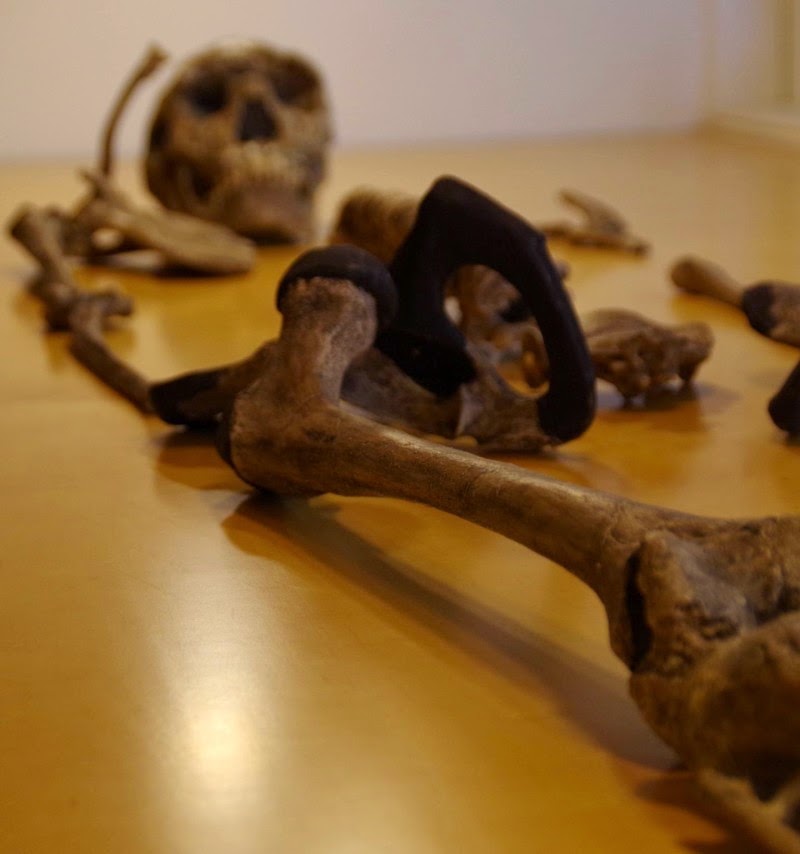
New research harnessing fragmentary fossils suggests our genus has come in different shapes and sizes since its origins over two million years ago, and adds weight to the idea that humans began to colonise Eurasia while still small and lightweight.
One of the dominant theories of our evolution is that our genus, Homo, evolved from small-bodied early humans to become the taller, heavier and longer legged Homo erectus that was able to migrate beyond Africa and colonise Eurasia. While we know that small-bodied Homo erectus — averaging less than five foot (152cm) and under 50kg — were living in Georgia in southern Europe by 1.77 million years ago, the timing and geographic origin of the larger body size that we associate with modern humans has, until now, remained unresolved.
But a joint study by researchers at the Universities of Cambridge and Tübingen (Germany), published today in the Journal of Human Evolution, has now shown that the main increase in body size occurred tens of thousands of years after Homo erectus left Africa, and primarily in the Koobi Fora region of Kenya. According to Manuel Will, a co-author of the study from the Department of Early Prehistory and Quaternary Ecology at Tübingen, “the evolution of larger bodies and longer legs can thus no longer be assumed to be the main driving factor behind the earliest excursions of our genus to Eurasia.”
Researchers say the results from a new research method, using tiny fragments of fossil to estimate our earliest ancestors’ height and body mass, also point to the huge diversity in body size we see in humans today emerging much earlier than previously thought.
“What we’re seeing is perhaps the beginning of a unique characteristic of our own species — the origins of diversity,” said Dr Jay Stock, co-author of the study from the University of Cambridge’s Department of Archaeology and Anthropology. “It’s possible to interpret our findings as showing that there were either multiple species of early human, such as Homo habilis, Homo ergaster and Homo rudolfensis, or one highly diverse species. This fits well with recent cranial evidence for tremendous diversity among early members of the genus Homo.”
“If someone asked you ‘are modern humans 6 foot tall and 70kg?’ you’d say ‘well some are, but many people aren’t,’ and what we’re starting to show is that this diversification happened really early in human evolution,” said Stock.
The study is the first in 20 years to compare the body size of the humans who shared earth with mammoths and sabre-toothed cats between 2.5 and 1.5 million years ago. It is also the first time that many fragmentary fossils — some as small as toes and tiny ankle bones no more than 5cm long — have been used to make body size estimates.
Comparing measurements of fossils from sites in Kenya, Tanzania, South Africa, and Georgia, the researchers found that there was significant regional variation in the size of early humans during the Pleistocene. Some groups, such as those who lived in South African caves, averaged 4.8 feet tall; some of those found in Kenya’s Koobi Fora region would have stood at almost 6 foot, comparable to the average of today´s male population in Britain.
“Basically every textbook on human evolution gives the perspective that one lineage of humans evolved larger bodies before spreading beyond Africa. But the evidence for this story about our origins and the dispersal out of Africa just no longer really fits,” said Stock. “The first clues came from the site of Dmanisi in Georgia where fossils of really small-bodied people date to 1.77 million years ago. This has been known for several years, but we now know that consistently larger body size evolved in Eastern Africa after 1.7 million years ago, in the Koobi Fora region of Kenya.”
“We tend to simplify our interpretations because the fossil record is patchy and we have to explain it in some way. But revealing the diversity that exists is just as important as those broad, sweeping explanations.”
Previous studies have been based on small samples of only 10-15 fossils because techniques for calculating the height and body mass of individuals required specific pieces of bone such as the hip joint or most of a leg bone. Stock and Will have used a sample size three times larger, estimating body size for over 40 specimens contained in collections all over Africa and Georgia, making it the largest comparative study conducted so far.
Instead of waiting for new fossils to be discovered and hoping that they contained these specific bones, Stock and Will decided to try a different approach and make use of previously over-looked fossils. In what Stock describes as a “very challenging project,” they spent a year developing new equations that allowed them to calculate the height and body mass of individuals using much smaller bones, some as small as toes. By comparing these bones to measurements taken from over 800 modern hunter-gatherer skeletons from around the world and applying various regression equations, the researchers were able to estimate body size for many new fossils that have never been studied in this way before.
“In human evolution we see body size as one of the most important characteristics, and from examining these ‘scrappier’ fossils we can get a much better sense of when and where human body size diversity arose. Before 1.7 million years ago our ancestors were seldom over 5 foot tall or particularly heavy in body mass.
“When this significant size shift to much heavier, taller individuals happened, it occurred primarily in one particular place — in a region called Koobi Fora in northern Kenya around 1.7 million years ago. That means we can now start thinking about what regional conditions drove the emergence of this diversity, rather than seeing body size as a fixed and fundamental characteristic of a species,” said Stock.
Reference:
Manuel Will, Jay T. Stock. Spatial and temporal variation of body size among early Homo. Journal of Human Evolution, 2015 DOI: 10.1016/j.jhevol.2015.02.009
Note: The above story is based on materials provided by University of Cambridge. The original story is licensed under a Creative Commons Licence.
Deadly Japan quake and tsunami spurred global warming, ozone loss
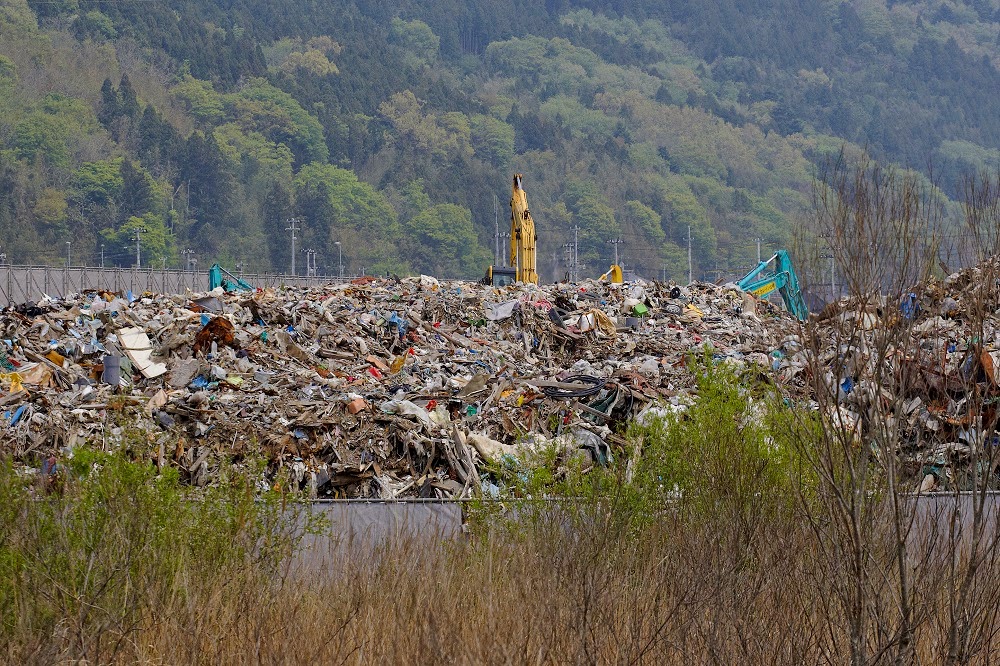
Buildings destroyed by the 2011 Tohoku earthquake released thousands of tons of climate-warming and ozone-depleting chemicals into the atmosphere, according to a new study.
New research suggests that the thousands of buildings destroyed and damaged during the 9.0 magnitude earthquake and tsunami that struck Japan four years ago released 6,600 metric tons (7,275 U.S. tons) of gases stored in insulation, appliances and other equipment into the atmosphere.
Emissions of these chemicals, called halocarbons, increased by 21 percent to 91 percent over typical levels, according to the new study accepted for publication in Geophysical Research Letters, a journal of the American Geophysical Union.
First look
The study is the first to look at how the Tohoku earthquake affected the release of halocarbons into the atmosphere and likely one of the first to examine emissions of these gases following a natural disaster, according to the study’s authors.
“What we found is a new mechanism of halocarbon emissions coming from the earthquake,” said Takuya Saito, a senior researcher at the National Institute for Environmental Studies in Tsukuba, Japan, and lead author of the new paper.
Halocarbons released as a result of the earthquake include chemicals that deplete the ozone layer and contribute to global warming — including some gases that are no longer used because of those harmful effects on the environment. These include chlorofluorocarbons like CFC-11, a powerful ozone-depleting chemical used in foam insulation until it was phased out in 1996, and hydrochlorofluorocarbons like HCFC-22, an ozone-depleting refrigerant that is also a powerful greenhouse gas and is in the process of being phased out of use. Among other halocarbons released by the earthquake were hydrofluorocarbons, or HFCs, and sulfur hexafluoride, both potent greenhouse gases.
The emissions of the six halocarbons released from Japan in 2011 are equivalent to the discharge of 1,300 metric tons (1,433 U.S. tons) of CFC-11 alone — equal to the amount of CFC-11s found in 2.9 million refrigerators manufactured before the chemical was banned. The total emissions of the six chemicals are also equivalent to the release of 19.2 million metric tons (21.2 million U.S. tons) of carbon dioxide into the atmosphere — an amount equal to about 10 percent of Japanese vehicle emissions in 2011, according to the study’s authors.
Post-quake surprise
Saito and his colleagues decided to investigate halocarbon emissions and their relationship to the earthquake after ground-based air monitoring stations in Japan recorded surprising high levels of these chemicals. The stations are on Hateruma Island, east of Taiwan; Cape Ochiishi, on the east side of Hokkaido; and Ryori, north of Tokyo on Honshu.
The study’s authors combined these measurements with an atmospheric model and other mathematical methods to figure out that increased emissions from the earthquake were involved, how much of the emissions could be attributed to the disaster and how they compared to previous years.
They found that emissions of all six halocarbons were higher from March 2011 to February 2012, following the earthquake, than they were during the same time the year before the event and during the same period the year after it.
About 50 percent of the halocarbon emissions after the earthquake were of HCFC-22, likely due to damage to refrigerators and air conditioners. Emissions of the gas were 38 percent higher than the years before and after the earthquake. Emissions of CFC-11 were 72 percent higher than emissions before and after the earthquake, likely due to damage to insulation foams used in appliances and buildings, according to the study. Emissions of two types of HFCs — HFC-134a and HFC-32 — rose by 49 percent and 63 percent compared to the years before and after the disaster.
Impacts assessed
The new study also calculates the total impact of the increased emissions on ozone depletion and global warming. The earthquake-triggered surge of halocarbons increased ozone loss from Japanese emissions of those six gases by 38 percent from March 2011 to February 2012 compared to the same time period in the years before and after the event. The amount of heat trapped in the atmosphere because of Japan’s emissions of those six gases rose 36 percent from March 2011 to February 2012 compared to earlier and later years because of the extra emissions from the earthquake, according to the new study.
Saito said the new study shows the importance of including the release of gases from natural disasters in emissions estimates. Although the global effect of one event is small — emissions associated with the Tohoku earthquake accounted for 4 percent or less of global emissions in 2011 — the cumulative effect could be larger, he said. Natural disasters accelerate the release of halocarbons and replacement of these gases could lead to the use of more halocarbons, according to the study.
National halocarbon emissions estimates by the Japanese government did not factor in the release of the chemicals due to the earthquake and are likely underestimating the amount of these substances in the atmosphere, according to Saito. Governments rely on inventories of chemicals and generic data about how they are used to estimate their amounts in the atmosphere — called a “bottom-up” approach” — whereas the new study uses actual measurements of the gases — called a “top-down” approach. “It is apparent that there are unreported emissions,” Saito said.
The new study shows that there could be a need to include the amount of halocarbons released by catastrophic events in emissions estimates, said Steve Montzka, a research chemist at the National Oceanic and Atmospheric Administration in Boulder, Colorado, who was not involved in the research. It also highlights the need for more measurements of halocarbons in the atmosphere, he added, rather than relying on bottom-up emissions estimates from inventories.
“Atmospheric scientists often say that relying solely on bottom-up inventories to tell you how greenhouse gas emissions change is like going on a diet without weighing yourself,” Montzka said.
Reference:
Takuya Saito, Xuekun Fang, Andreas Stohl, Yoko Yokouchi, Jiye Zeng, Yukio Fukuyama, Hitoshi Mukai. Extraordinary halocarbon emissions initiated by the 2011 Tohoku earthquake. Geophysical Research Letters, 2015; DOI: 10.1002/2014GL062814
Note: The above story is based on materials provided by American Geophysical Union.
Mount St. Helens: May 18, 1980
USGS scientists recount their experiences before, during and after the May 18, 1980 eruption of Mount St. Helens. Loss of their colleague David A. Johnston and 56 others in the eruption cast a pall over one of the most dramatic geologic moments in American history.
Video Provided by: USGS
Mariana Trench “Deepest Part of the Ocean”
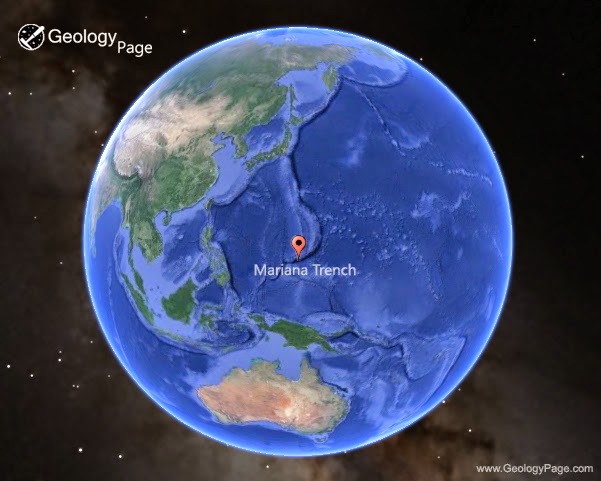
The Mariana Trench or Marianas Trench is the deepest part of the world’s oceans. It is located in the western Pacific Ocean, to the east of the Mariana Islands. The trench is about 2,550 kilometres (1,580 mi) long but has an average width of only 69 kilometres (43 mi). It reaches a maximum-known depth of 10,994 m (± 40 m) or 6.831 mi (36,070 ± 131 ft) at the Challenger Deep, a small slot-shaped valley in its floor, at its southern end, although some unrepeated measurements place the deepest portion at 11.03 kilometres (6.85 mi).
At the bottom of the trench the water column above exerts a pressure of 1,086 bars (15,750 psi), over 1000 times the standard atmospheric pressure at sea level. At this pressure the density of water is increased by 4.96%, making 95 litres of water under the pressure of the Challenger Deep contain the same mass as 100 litres at the surface. The temperature at the bottom is 1 to 4 °C.
The trench is not the part of the seafloor closest to the center of the Earth. This is because the Earth is not a perfect sphere: its radius is about 25 kilometres (16 mi) less at the poles than at the equator. As a result, parts of the Arctic Ocean seabed are at least 13 kilometres (8.1 mi) closer to the Earth’s center than the Challenger Deep seafloor.
Xenophyophores have been found in the trench by Scripps Institution of Oceanography researchers at a record depth of 10.6 km (6.6 mi) below the sea surface. On 17 March 2013, researchers reported data that suggested microbial life forms thrive within the trench.
Names
The Mariana Trench is named for the nearby Mariana Islands (in turn named Las Marianas in honor of Spanish Queen Mariana of Austria, widow of Philip IV of Spain). The islands are part of the island arc that is formed on an over-riding plate, called the Mariana Plate (also named for the islands), on the western side of the trench.
Geology
The Mariana Trench is part of the Izu-Bonin-Mariana subduction system that forms the boundary between two tectonic plates. In this system, the western edge of one plate, the Pacific Plate, is subducted (i.e., thrust) beneath the smaller Mariana Plate that lies to the west. Crustal material at the western edge of the Pacific Plate is some of the oldest oceanic crust on earth (up to 170 million years old), and is therefore cooler and more dense; hence its great height difference relative to the higher-riding (and younger) Mariana Plate. The deepest area at the plate boundary is the Mariana Trench proper.
The movement of the Pacific and Mariana plates is also indirectly responsible for the formation of the Mariana Islands. These volcanic islands are caused by flux melting of the upper mantle due to release of water that is trapped in minerals of the subducted portion of the Pacific Plate.
Measurements
The trench was first sounded during the Challenger expedition in 1875, which recorded a depth of 4,475 fathoms (8.184 km). In 1877 a map was published called Tiefenkarte des Grossen Ozeans by Petermann, which showed a Challenger Tief at the location of that sounding. In 1899 USS Nero, a converted collier, recorded a depth of 5269 fathoms (9,636 m, 31,614 ft). Challenger II surveyed the trench using echo sounding, a much more precise and vastly easier way to measure depth than the sounding equipment and drag lines used in the original expedition. During this survey, the deepest part of the trench was recorded when the Challenger II measured a depth of 5,960 fathoms (10,900 m, 35,760 ft) at 11°19′N 142°15′E, known as the Challenger Deep.
In 1957, the Soviet vessel Vityaz reported a depth of 11,034 m (36,201 ft), dubbed the Mariana Hollow.
In 1962, the surface ship M.V. Spencer F. Baird recorded a maximum depth of 10,915 m (35,840 ft), using precision depth gauges.
In 1984, the Japanese survey vessel Takuyō , collected data from the Mariana Trench using a narrow, multi-beam echo sounder; it reported a maximum depth of 10,924 m, also reported as 10,920 ± 10 metres.
Remotely Operated Vehicle KAIKO reached the deepest area of Mariana trench and made the deepest diving record of 10,911 m on March 24, 1995.
During surveys carried out between 1997 and 2001, a spot was found along the Mariana Trench that had depth similar to that of the Challenger Deep, possibly even deeper. It was discovered while scientists from the Hawaii Institute of Geophysics and Planetology were completing a survey around Guam; they used a sonar mapping system towed behind the research ship to conduct the survey. This new spot was named the HMRG (Hawaii Mapping Research Group) Deep, after the group of scientists who discovered it.
On 1 June 2009 sonar mapping of the Challenger Deep by the Simrad EM120 sonar multibeam bathymetry system for deep water (300–11,000 m) mapping aboard the RV Kilo Moana (mothership of the Nereus vehicle), has indicated a spot with a depth of 10,971 m (35,994 ft). The sonar system uses phase and amplitude bottom detection, with an accuracy of better than 0.2% of water depth across the entire swath (implying the depth figure is accurate to less than ± 22 metres).
In 2011, it was announced at the American Geophysical Union Fall Meeting that a US Navy hydrographic ship equipped with a multibeam echosounder conducted a survey which mapped the entire trench to 100 m resolution. The mapping revealed the existence of four rocky outcrops thought to be former seamounts.
The Mariana Trench is a site chosen by researchers at Washington University and the Woods Hole Oceanographic Institution in 2012 for a seismic survey to investigate the subsurface water cycle. Using seismometers and hydrophones the scientists are able to map structures as deep as 60 mi (97 km) beneath the surface.
How deep is the ocean?
The average ocean depth is 2.65 miles.
The average depth of the ocean is about 14,000 feet. The deepest part of the ocean is called the Challenger Deep and is located beneath the western Pacific Ocean in the southern end of the Mariana Trench, which runs several hundred kilometers southwest of the U.S. territorial island of Guam. Challenger Deep is approximately 36,200 feet deep. It is named after the HMS Challenger, whose crew first sounded the depths of the trench in 1875.
Map
Reference:
Wikipedia: Mariana Trench
National Ocean Service: How deep is the ocean?
Types of volcanic eruptions

During a volcanic eruption, lava, tephra (ash, lapilli, volcanic bombs and blocks), and various gases are expelled from a volcanic vent or fissure. Several types of volcanic eruptions have been distinguished by volcanologists. These are often named after famous volcanoes where that type of behavior has been observed. Some volcanoes may exhibit only one characteristic type of eruption during a period of activity, while others may display an entire sequence of types all in one eruptive series.
There are three different meta types of eruptions. The most well-observed are magmatic eruptions, which involve the decompression of gas within magma that propels it forward. Phreatomagmatic eruptions are another type of volcanic eruption, driven by the compression of gas within magma, the direct opposite of the process powering magmatic activity. The last eruptive metatype is the phreatic eruption, which is driven by the superheating of steam via contact with magma; these eruptive types often exhibit no magmatic release, instead causing the granulation of existing rock.
Within these wide-defining eruptive types are several subtypes. The weakest are Hawaiian and submarine, then Strombolian, followed by Vulcanian and Surtseyan. The stronger eruptive types are Pelean eruptions, followed by Plinian eruptions; the strongest eruptions are called “Ultra Plinian.” Subglacial and phreatic eruptions are defined by their eruptive mechanism, and vary in strength. An important measure of eruptive strength is Volcanic Explosivity Index (VEI), an order of magnitude scale ranging from 0 to 8 that often correlates to eruptive types.
Eruption mechanisms
Volcanic eruptions arise through three main mechanisms:
- Gas release under decompression causing magmatic eruptions
- Thermal contraction from chilling on contact with water causing phreatomagmatic eruptions
- Ejection of entrained particles during steam eruptions causing phreatic eruptions
There are two types of eruptions in terms of activity, explosive eruptions and effusive eruptions. Explosive eruptions are characterized by gas-driven explosions that propels magma and tephra.Effusive eruptions, meanwhile, are characterized by the outpouring of lava without significant explosive eruption.
Volcanic eruptions vary widely in strength. On the one extreme there are effusive Hawaiian eruptions, which are characterized by lava fountains and fluid lava flows, which are typically not very dangerous. On the other extreme, Plinian eruptions are large, violent, and highly dangerous explosive events. Volcanoes are not bound to one eruptive style, and frequently display many different types, both passive and explosive, even the span of a single eruptive cycle. Volcanoes do not always erupt vertically from a single crater near their peak, either. Some volcanoes exhibit lateral and fissure eruptions. Notably, many Hawaiian eruptions start from rift zones, and some of the strongest Surtseyan eruptions develop along fracture zones. Scientists believed that pulses of magma mixed together in the chamber before climbing upward—a process estimated to take several thousands of years. But Columbia University volcanologists found that the eruption of Costa Rica’s Irazú Volcano in 1963 was likely triggered by magma that took a nonstop route from the mantle over just a few months.
Magmatic eruptions
Magmatic eruptions produce juvenile clasts during explosive decompression from gas release. They range in intensity from the relatively small lava fountains on Hawaii to catastrophic Ultra Plinian eruption columns more than 30 km (19 mi) high, bigger than the eruption of Mount Vesuvius in 79 that buried Pompeii.
Hawaiian
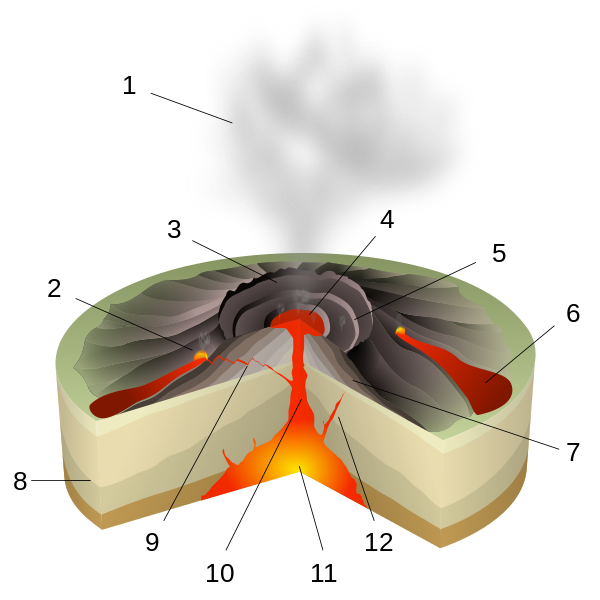
Hawaiian eruptions are a type of volcanic eruption, named after the Hawaiian volcanoes with which this eruptive type is hallmark. Hawaiian eruptions are the calmest types of volcanic events, characterized by the effusive eruption of very fluid basalt-type lavas with low gaseous content. The volume of ejected material from Hawaiian eruptions is less than half of that found in other eruptive types. Steady production of small amounts of lava builds up the large, broad form of a shield volcano. Eruptions are not centralized at the main summit as with other volcanic types, and often occur at vents around the summit and from fissure vents radiating out of the center.
Hawaiian eruptions often begin as a line of vent eruptions along a fissure vent, a so-called “curtain of fire.” These die down as the lava begins to concentrate at a few of the vents. Central-vent eruptions, meanwhile, often take the form of large lava fountains (both continuous and sporadic), which can reach heights of hundreds of meters or more. The particles from lava fountains usually cool in the air before hitting the ground, resulting in the accumulation of cindery scoria fragments; however, when the air is especially thick with clasts, they cannot cool off fast enough due to the surrounding heat, and hit the ground still hot, the accumulation of which forms spatter cones. If eruptive rates are high enough, they may even form splatter-fed lava flows. Hawaiian eruptions are often extremely long lived; Pu’u O’o, a cinder cone of Kilauea, has been erupting continuously since 1983. Another Hawaiian volcanic feature is the formation of active lava lakes, self-maintaining pools of raw lava with a thin crust of semi-cooled rock; there are currently only 5 such lakes in the world, and the one at Kīlauea’s Kupaianaha vent is one of them.
Strombolian
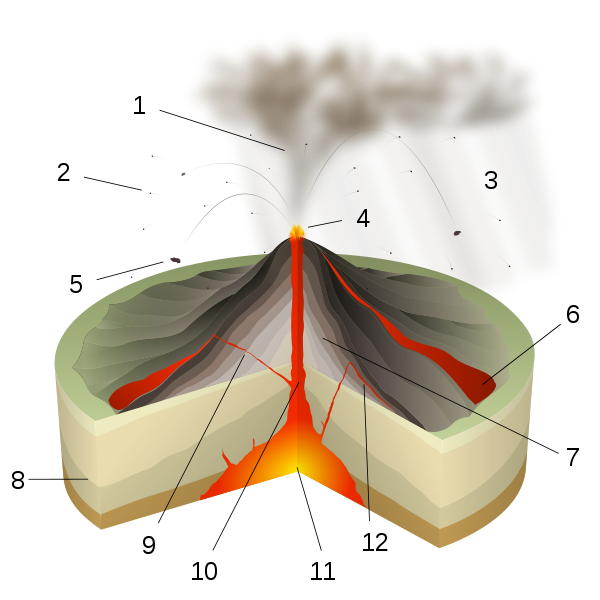
Strombolian eruptions are a type of volcanic eruption, named after the volcano Stromboli, which has been erupting continuously for centuries. Strombolian eruptions are driven by the bursting of gas bubbles within the magma. These gas bubbles within the magma accumulate and coalesce into large bubbles, called gas slugs. These grow large enough to rise through the lava column. Upon reaching the surface, the difference in air pressure causes the bubble to burst with a loud pop, throwing magma in the air in a way similar to a soap bubble. Because of the high gas pressures associated with the lavas, continued activity is generally in the form of episodic explosive eruptions accompanied by the distinctive loud blasts. During eruptions, these blasts occur as often as every few minutes.
The term “Strombolian” has been used indiscriminately to describe a wide variety of volcanic eruptions, varying from small volcanic blasts to large eruptive columns. In reality, true Strombolian eruptions are characterized by short-lived and explosive eruptions of lavas with intermediate viscosity, often ejected high into the air. Columns can measure hundreds of meters in height. The lavas formed by Strombolian eruptions are a form of relatively viscous basaltic lava, and its end product is mostly scoria. The relative passivity of Strombolian eruptions, and its non-damaging nature to its source vent allow Strombolian eruptions to continue unabated for thousands of years, and also makes it one of the least dangerous eruptive types.
Strombolian eruptions eject volcanic bombs and lapilli fragments that travel in parabolic paths before landing around their source vent. The steady accumulation of small fragments builds cinder cones composed completely of basaltic pyroclasts. This form of accumulation tends to result in well-ordered rings of tephra.
Strombolian eruptions are similar to Hawaiian eruptions, but there are differences. Strombolian eruptions are noisier, produce no sustained eruptive columns, do not produce some volcanic products associated with Hawaiian volcanism (specifically Pele’s tears and Pele’s hair), and produce fewer molten lava flows (although the eruptive material does tend to form small rivulets).
Vulcanian
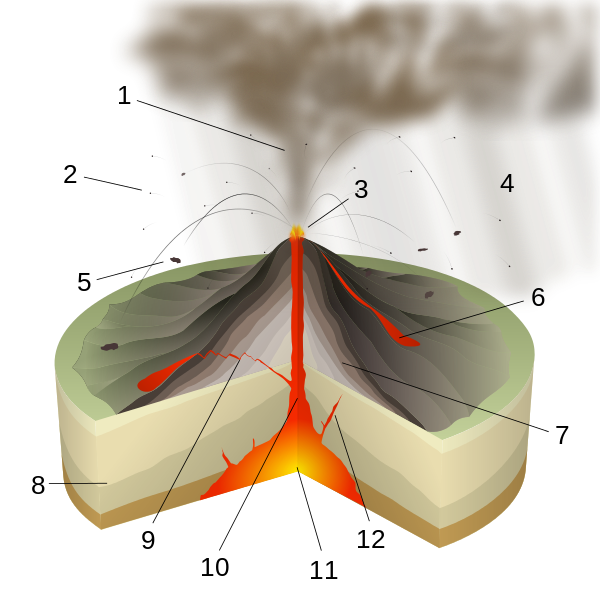
Vulcanian eruptions are a type of volcanic eruption, named after the volcano Vulcano, which means the word Volcano. It was named so following Giuseppe Mercalli’s observations of its 1888-1890 eruptions. In Vulcanian eruptions, highly viscous magma within the volcano make it difficult for vesiculate gases to escape. Similar to Strombolian eruptions, this leads to the buildup of high gas pressure, eventually popping the cap holding the magma down and resulting in an explosive eruption. However, unlike Strombolian eruptions, ejected lava fragments are not aerodynamic; this is due to the higher viscosity of Vulcanian magma and the greater incorporation of crystalline material broken off from the former cap. They are also more explosive than their Strombolian counterparts, with eruptive columns often reaching between 5 and 10 km (3 and 6 mi) high. Lastly, Vulcanian deposits are andesitic to dacitic rather than basaltic.
Initial Vulcanian activity is characterized by a series of short-lived explosions, lasting a few minutes to a few hours and typified by the ejection of volcanic bombs and blocks. These eruptions wear down the lava dome holding the magma down, and it disintegrates, leading to much more quiet and continuous eruptions. Thus an early sign of future Vulcanian activity is lava dome growth, and its collapse generates an outpouring of pyroclastic material down the volcano’s slope.
Peléan
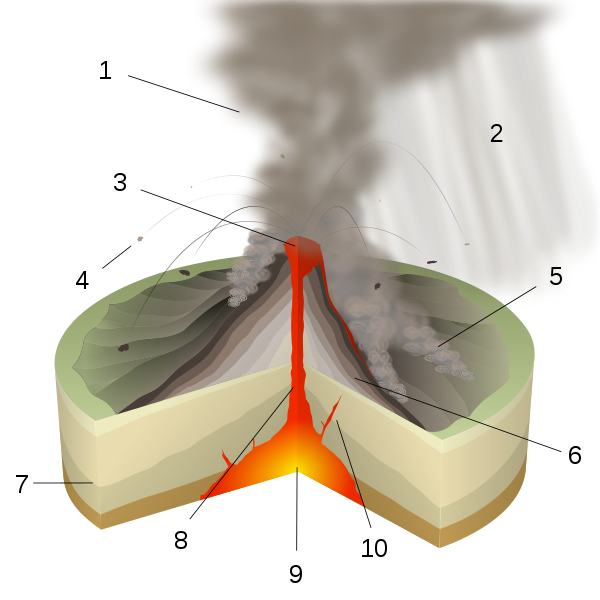
Peléan eruptions (or nuée ardente) are a type of volcanic eruption, named after the volcano Mount Pelée in Martinique, the site of a massive Peléan eruption in 1902 that is one of the worst natural disasters in history. In Peléan eruptions, a large amount of gas, dust, ash, and lava fragments are blown out the volcano’s central crater, driven by the collapse of rhyolite, dacite, and andesite lava dome collapses that often create large eruptive columns. An early sign of a coming eruption is the growth of a so-called Peléan or lava spine, a bulge in the volcano’s summit preempting its total collapse. The material collapses upon itself, forming a fast-moving pyroclastic flow (known as a block-and-ash flow) that moves down the side of the mountain at tremendous speeds, often over 150 km (93 mi) per hour. These massive landslides make Peléan eruptions one of the most dangerous in the world, capable of tearing through populated areas and causing massive loss of life. The 1902 eruption of Mount Pelée caused tremendous destruction, killing more than 30,000 people and competely destroying the town of St. Pierre, the worst volcanic event in the 20th century.
Peléan eruptions are characterized most prominently by the incandescent pyroclastic flows that they drive. The mechanics of a Peléan eruption are very similar to that of a Vulcanian eruption, except that in Peléan eruptions the volcano’s structure is able to withstand more pressure, hence the eruption occurs as one large explosion rather than several smaller ones.
Plinian
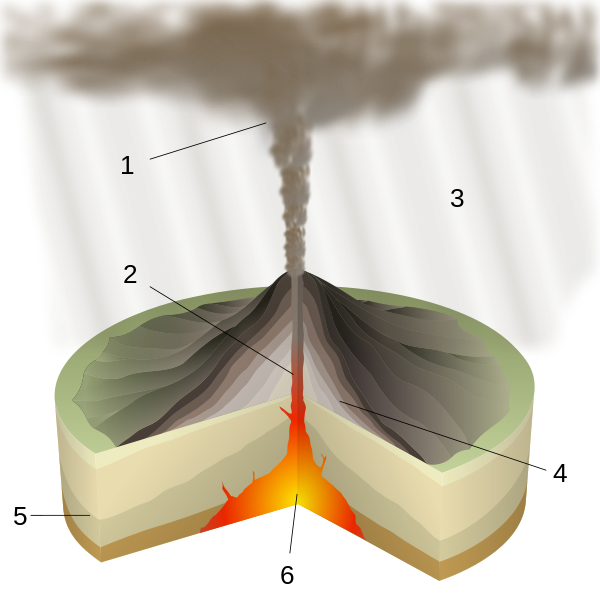
Plinian eruptions (or Vesuvian) are a type of volcanic eruption, named for the historical eruption of Mount Vesuvius in 79 of Mount Vesuvius that buried the Roman towns of Pompeii and Herculaneum, and specifically for its chronicler Pliny the Younger. The process powering Plinian eruptions starts in the magma chamber, where dissolved volatile gases are stored in the magma. The gases vesiculate and accumulate as they rise through the magma conduit. These bubbles agglutinate and once they reach a certain size (about 75% of the total volume of the magma conduit) they explode. The narrow confines of the conduit force the gases and associated magma up, forming an eruptive column. Eruption velocity is controlled by the gas contents of the column, and low-strength surface rocks commonly crack under the pressure of the eruption, forming a flared outgoing structure that pushes the gases even faster.
These massive eruptive columns are the distinctive feature of a Plinian eruption, and reach up 2 to 45 km (1 to 28 mi) into the atmosphere. The densest part of the plume, directly above the volcano, is driven internally by gas expansion. As it reaches higher into the air the plume expands and becomes less dense, convection and thermal expansion of volcanic ash drive it even further up into the stratosphere. At the top of the plume, powerful prevailing winds drive the plume in a direction away from the volcano.
Plinian eruptions are similar to both Vulcanian and Strombolian eruptions, except that rather than creating discrete explosive events, Plinian eruptions form sustained eruptive columns. They are also similar to Hawaiian lava fountains in that both eruptive types produce sustained eruption columns maintained by the growth of bubbles that move up at about the same speed as the magma surrounding them.
Phreatomagmatic eruptions
Phreatomagmatic eruptions are eruptions that arise from interactions between water and magma. They are driven from thermal contraction (as opposed to magmatic eruptions, which are driven by thermal expansion) of magma when it comes in contact with water. This temperature difference between the two causes violent water-lava interactions that make up the eruption. The products of phreatomagmatic eruptions are believed to be more regular in shape and finer grained than the products of magmatic eruptions because of the differences in eruptive mechanisms.
There is debate about the exact nature of phreatomagmatic eruptions, and some scientists believe that fuel-coolant reactions may be more critical to the explosive nature than thermal contraction. Fuel coolant reactions may fragment the volcanic material by propagating stress waves, widening cracks and increasing surface area that ultimetly lead to rapid cooling and explosive contraction-driven eruptions.
Surtseyan
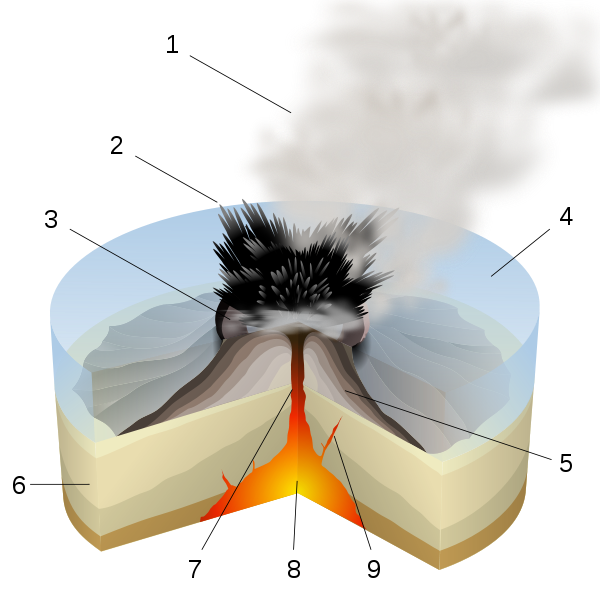
A Surtseyan eruption (or hydrovolcanic) is a type of volcanic eruption caused by shallow-water interactions between water and lava, named so after its most famous example, the eruption and formation of the island of Surtsey off the coast of Iceland in 1963. Surtseyan eruptions are the “wet” equivalent of ground-based Strombolian eruptions, but because of where they are taking place they are much more explosive. This is because as water is heated by lava, it flashes in steam and expands violently, fragmenting the magma it is in contact with into fine-grained ash. Surtseyan eruptions are the hallmark of shallow-water volcanic oceanic islands, however they are not specifically confined to them. Surtseyan eruptions can happen on land as well, and are caused by rising magma that comes into contact with an aquifer (water-bearing rock formation) at shallow levels under the volcano. The products of Surtseyan eruptions are generally oxidized palagonite basalts (though andesitic eruptions do occur, albeit rarely), and like Strombolian eruptions Surtseyan eruptions are generally continuous or otherwise rhythmic.
Submarine
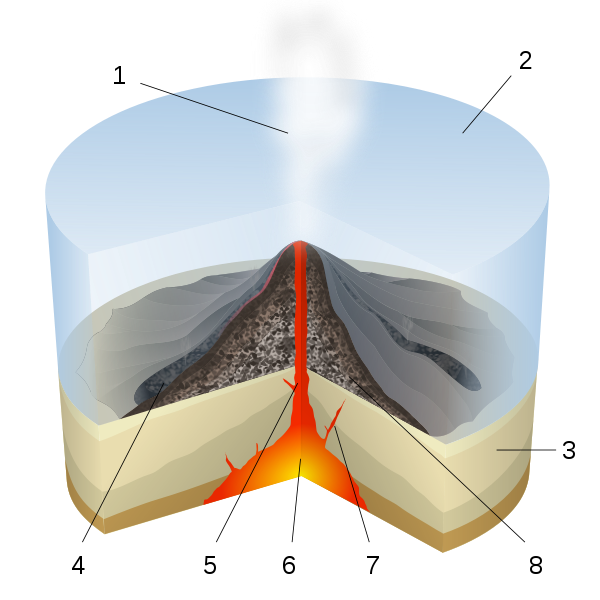
Submarine eruptions are a type of volcanic eruption that occurs underwater. An estimated 75% of the total volcanic eruptive volume is generated by submarine eruptions near mid ocean ridges alone, however because of the problems associated with detecting deep sea volcanics, they remained virtually unknown until advances in the 1990s made it possible to observe them.
Submarine eruptions may produce seamounts which may break the surface to form volcanic islands and island chains.
Submarine volcanism is driven by various processes. Volcanoes near plate boundaries and mid-ocean ridges are built by the decompression melting of mantle rock that rises on an upwelling portion of a convection cell to the crustal surface. Eruptions associated with subducting zones, meanwhile, are driven by subducting plates that add volatiles to the rising plate, lowering its melting point. Each process generates different rock; mid-ocean ridge volcanics are primarily basaltic, whereas subduction flows are mostly calc-alkaline, and more explosive and viscous.
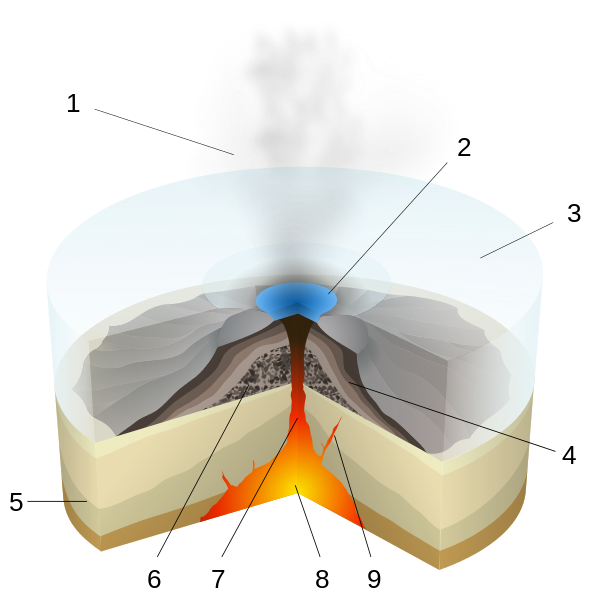
Subglacial
Subglacial eruptions are a type of volcanic eruption characterized by interactions between lava and ice, often under a glacier. The nature of glaciovolcanism dictates that it occurs at areas of high latitude and high altitude. It has been suggested that subglacial volcanoes that are not actively erupting often dump heat into the ice covering them, producing meltwater. This meltwater mix means that subglacial eruptions often generate dangerous jökulhlaups (floods) and lahars.
The study of glaciovolcanism is still a relatively new field. Early accounts described the unusual flat-topped steep-sided volcanoes (called tuyas) in Iceland that were suggested to have formed from eruptions below ice. The first English-language paper on the subject was published in 1947 by William Henry Mathews, describing the Tuya Butte field in northwest British Columbia, Canada. The eruptive process that builds these structures, originally inferred in the paper, begins with volcanic growth below the glacier. At first the eruptions resemble those that occur in the deep sea, forming piles of pillow lava at the base of the volcanic structure. Some of the lava shatters when it comes in contact with the cold ice, forming a glassy breccia called hyaloclastite. After a while the ice finally melts into a lake, and the more explosive eruptions of Surtseyan activity begins, building up flanks made up of mostly hyaloclastite. Eventually the lake boils off from continued volcanism, and the lava flows become more effusive and thicken as the lava cools much more slowly, often forming columnar jointing. Well-preserved tuyas show all of these stages, for example Hjorleifshofdi in Iceland.
Products of volcano-ice interactions stand as various structures, whose shape is dependent on complex eruptive and environmental interactions. Glacial volcanism is a good indicator of past ice distribution, making it an important climatic marker. Since they are imbedded in ice, as ice retracts worldwide there are concerns that tuyas and other structures may destabalize, resulting in mass landslides. Evidence of volcanic-glacial interactions are evident in Iceland and parts of British Columbia, and it’s even possible that they play a role in deglaciation.
Phreatic eruptions
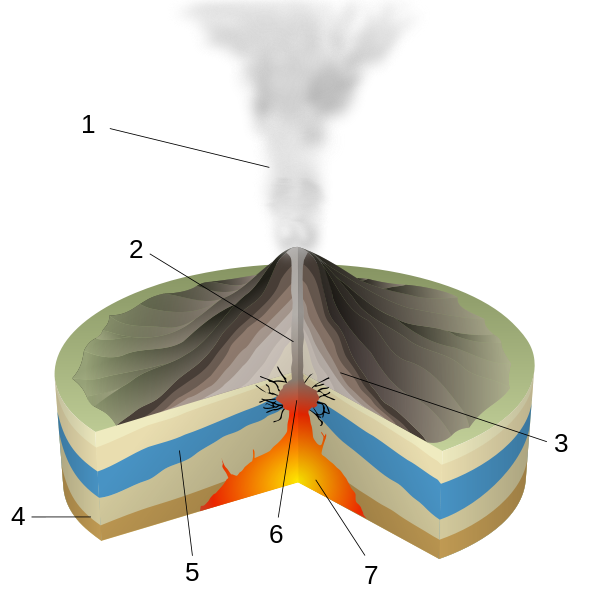
Phreatic eruptions (or steam-blast eruptions) are a type of eruption driven by the expansion of steam. When cold ground or surface water come into contact with hot rock or magma it superheats and explodes, fracturing the surrounding rock and thrusting out a mixture of steam, water, ash, volcanic bombs, and volcanic blocks. The distinguishing feature of phreatic explosions is that they only blast out fragments of pre-existing solid rock from the volcanic conduit; no new magma is erupted. Because they are driven by the cracking of rock stata under pressure, phreatic activity does not always result in an eruption; if the rock face is strong enough to withstand the explosive force, outright eruptions may not occur, although cracks in the rock will probably develop and weaken it, furthering future eruptions.
Often a precursor of future volcanic activity, phreatic eruptions are generally weak, although there have been exceptions. Some phreatic events may be triggered by earthquake activity, another volcanic precursor, and they may also travel along dike lines. Phreatic eruptions form base surges, lahars, avalanches, and volcanic block “rain.” They may also release deadly toxic gas able to suffocate anyone in range of the eruption.
Photos
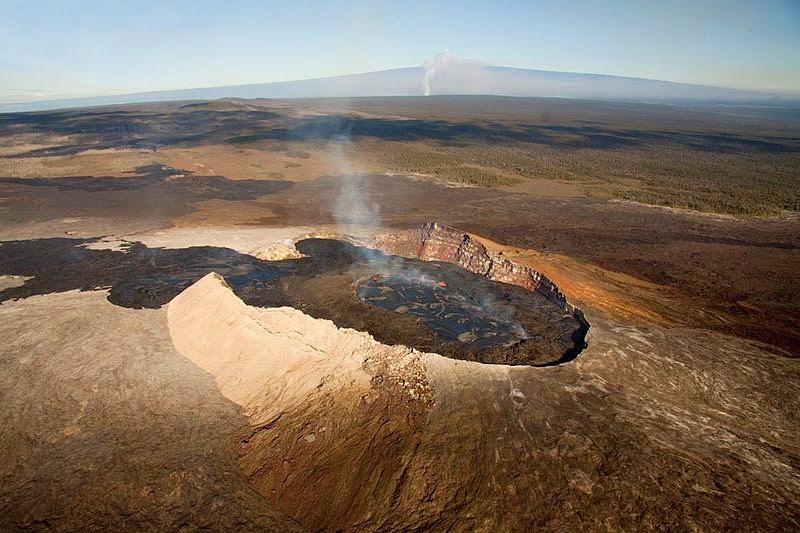
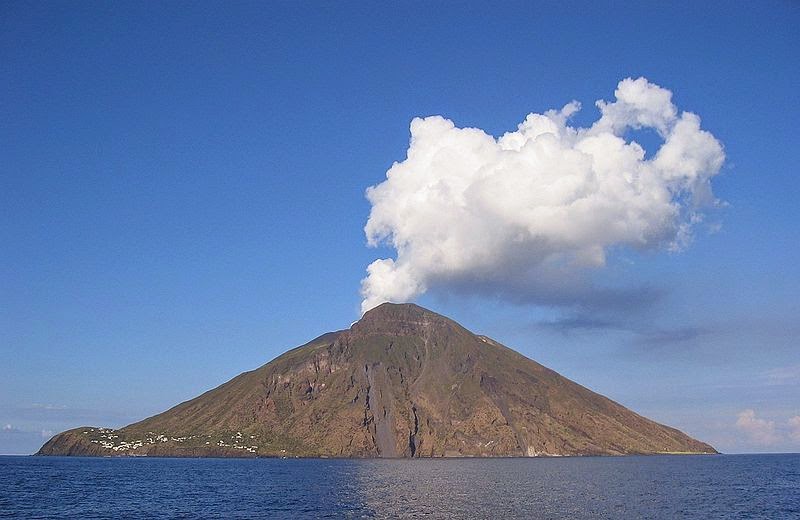
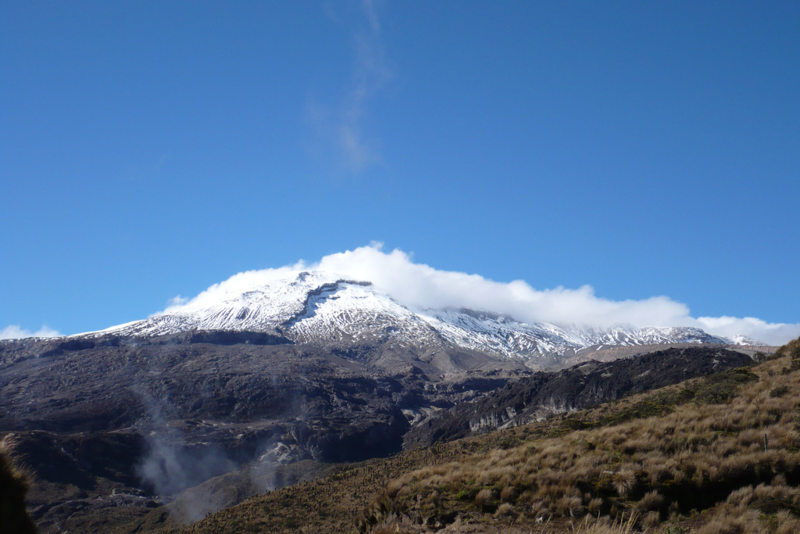
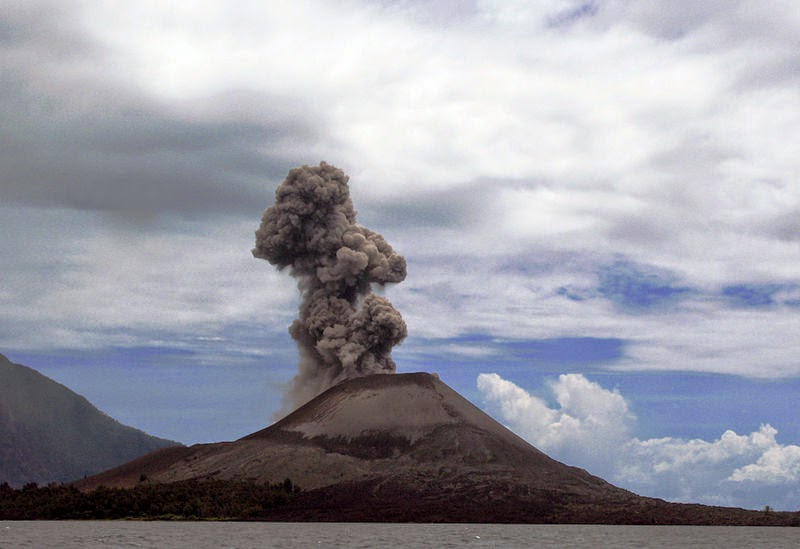
Reference:
USGS : Types of Volcanic Eruptions
University of Hawai‘i : HAWAIIAN ERUPTIONS
Wikipedia: Types of volcanic eruptions
University of California : VOLCANIC ACTIVITY AND ERUPTIONS
Preparing Boston for the “big one”

In 1755, a major earthquake shook the Boston area, toppling chimneys and inspiring sermons and poems about the wrath of God, such as “Earthquakes the Works of God and Tokens of his Just Displeasure” and “The Duty of a People, Under Dark Providences.” The quake, whose epicenter was about 25 miles from Massachusetts’ Cape Anne and 50 miles out to sea from Boston, measured an estimated 6.0 to 6.3 on the Richter scale. Since then, Bostonians have not had to worry much about the ground beneath them. In fact, preparing for earthquakes is probably near the bottom of the city’s to do list. But what if another major earthquake were to strike? According to SUTD-MIT postdoctoral fellow Ornella Iuorio, it would not be good.
Iuorio, who hails from earthquake-prone Italy, is spending one year at MIT, followed by a second year at the Singapore University of Technology and Design (SUTD), carrying out collaborative research with MIT Professor John Ochsendorf and SUTD professor Jeffrey Huang. For a large part of her career, Iuorio has focused on designing resilient new buildings that can withstand seismic events. Now, she is turning her attention to making historic buildings and neighborhoods earthquake-safe, with the ultimate aim of developing a tool that urban planners could use to decide which retrofit options make the most sense in a particular area.
Her project, “Smart Retrofit for Resilient Historic Cities,” is part of a comprehensive case study of Boston’s historic Back Bay neighborhood. Other researchers, including professor and MIT-SUTD International Design Center director John Fernandez and visiting scholar Nino Barbalace, have already begun studying Back Bay with an eye toward environmental retrofits. Therefore, Iuorio and Ochsendorf decided to complement that work by focusing on structural aspects.
Although it may seem unusual to examine earthquake resilience in an area seldom struck by earthquakes, Back Bay is an excellent site for the study. Like many historically valuable and beautiful urban neighborhoods, it is also extremely vulnerable to damage. Back Bay homes were primarily constructed of unreinforced masonry, which crumbles fairly easily. Furthermore, the entire development sits on what was once a mud flat, which was filled over the course of the 19th century. Although filled land is solid enough to build on, it still contains water. When the earth moves, it tends to liquefy. The fill layer can also settle and sink, exposing foundation posts to air and leaving them vulnerable to dry rot. In 1755, Boston’s population was much smaller, and Back Bay did not exist, so the Cape Anne earthquake caused only minor damage. It is estimated that an earthquake of similar magnitude today would cost billions of dollars and hundreds or even thousands of lives.
If planners hope to mitigate destruction in a place like Back Bay, the challenge, as Iuorio sees it, is to balance the various, often competing, factors involved, including safety, economic cost, environmental cost of the retrofit materials, and the historical value of the buildings. There are structural retrofits that can be easily applied, such as chains or fibrous mesh to hold the walls together as a unit. However, such retrofits can be costly, and may destroy some of the historical character of a neighborhood like Back Bay. Iuorio’s model would generate multiple solutions for structural retrofitting depending on the relative weight given to each of the factors. From the various options, city planners could choose the one that makes the most sense for the area in question.
The first phase of this project is a detailed classification of the thousand or so buildings that make up the neighborhood. Iuorio has been combing through old records and conducting on-site inspections to determine the type of construction used in each building, and to analyze potential vulnerabilities. Once this work is complete, she can begin to generate her model of retrofit options. In doing so, she says, it is important to consider the whole neighborhood, not just the individual structures. Since the buildings are directly adjacent, they act as a unit. If one begins to fold, those next to it will be affected as well. Therefore, not all retrofits would be equally effective. Reinforcing a structure at the end of a block, for example, may have more of an impact than reinforcing one in the middle of a row. Her model would make optimal suggestions based on the whole picture.
Will the mayor’s office be clamoring for the results and revising the city’s budget to allocate money for seismic retrofits? That’s unlikely, given the low probability of another major earthquake in the near future and more pressing concerns like snow removal and rising sea levels. However, the data provided by Iuorio’s study of the Back Bay neighborhood and the model she creates could serve other cities seeking to make their historic structures safer. In her second year of research, when she travels to Singapore, she may also apply the principles of her process on a larger scale, analyzing not just one neighborhood, but whole cities.
Scientists have learned a lot about why earthquakes occur since the Cape Anne event in the 18th century, but they still cannot predict when or where the next big quake may happen. Planners must make difficult decisions about how far to go in preparing for the unknown, and Iuorio is trying to make that process a little bit easier.
Note : The above story is based on materials provided by Massachusetts Institute of Technology.
New research predicts a doubling of coastal erosion by mid-century in Hawai’i
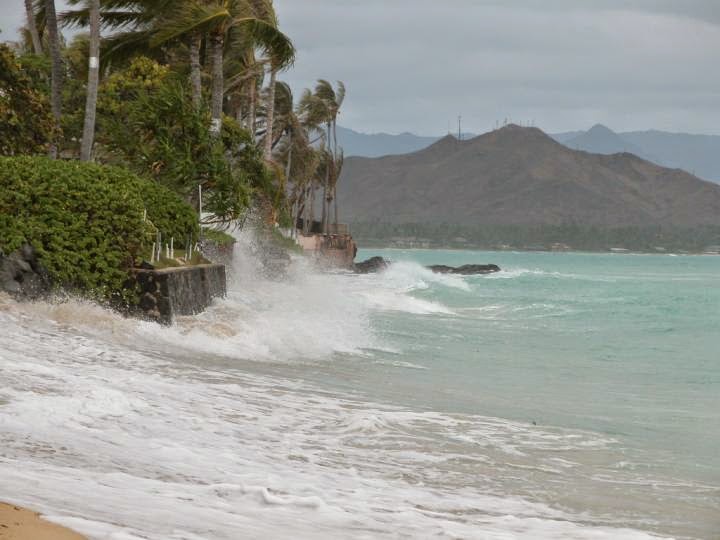
Chronic erosion dominates the sandy beaches of Hawai’i, causing beach loss as it damages homes, infrastructure, and critical habitat. Researchers have long understood that global sea level rise will affect the rate of coastal erosion. However, new research from scientists at the University of Hawaii – M?noa (UHM) and the Hawai’i Department of Land and Natural Resources brings into clearer focus just how dramatically Hawai’i beaches might change.
For the study, published this week in Natural Hazards, the research team developed a simple model to assess future erosion hazards under higher sea levels – taking into account historical changes of Hawai’i shorelines and the projected acceleration of sea level rise reported from the Intergovernmental Panel on Climate Change (IPCC). The results indicate that coastal erosion of Hawai’i’s beaches may double by mid-century.
Like the majority of Hawaii’s sandy beaches, most shorelines at the 10 study sites on Kauai, Oahu, and Maui are currently retreating. If these beaches were to follow current trends, an average 20 to 40 feet of shoreline recession would be expected by 2050 and 2100, respectively.
“When we modeled future shoreline change with the increased rates of sea level rise (SLR) projected under the IPCC’s “business as usual” scenario, we found that increased SLR causes an average 16 – 20 feet of additional shoreline retreat by 2050, and an average of nearly 60 feet of additional retreat by 2100,” said Tiffany Anderson, lead author and post-doctoral researcher at the UHM School of Ocean and Earth Science and Technology.
“This means that the average amount of shoreline recession roughly doubles by 2050 with increased SLR, compared to historical extrapolation alone. By 2100, it is nearly 2.5 times the historical extrapolation. Further, our results indicate that approximately 92% and 96% of the shorelines will be retreating by 2050 and 2100, respectively, except at Kailua, Oahu which is projected to begin retreating by mid-century.”
The model accounts for accretion of sand onto beaches and long-term sediment processes in making projections of future shoreline position. As part of ongoing research, the resulting erosion hazard zones are overlain on aerial photos and other geographic layers in a geographic information system to provide a tool for identifying resources, infrastructure, and property exposed to future coastal erosion.
“This study demonstrates a methodology that can be used by many shoreline communities to assess their exposure to coastal erosion resulting from the climate crisis,” said Chip Fletcher, Associate Dean at the UHM School of Ocean and Earth Science and Technology and co-author on the paper.
Mapping historical shoreline change provides useful data for assessing exposure to future erosion hazards, even if the rate of sea level rise changes in the future. The predicted increase in erosion will threaten thousands of homes, many miles of roadway and other assets in Hawai’i. Globally the asset exposure to erosion is enormous.
“With these new results government agencies can begin to develop adaptation strategies, including new policies, for safely developing the shoreline,” said Anderson.
To further improve the estimates of climate impacts, the next step for the team of researchers will be to combine the new model with assessments of increased flooding by waves.
The research was sponsored by the Hawaii Department of Land and Natural Resources, and the U.S. Geological Survey Pacific Islands Climate Science Center.
Reference:
Tiffany R. Anderson, Charles H. Fletcher, Matthew M. Barbee, L. Neil Frazer & Bradley M. Romine (2015). Doubling of coastal erosion under rising sea level by mid-century in Hawai’i. Natural Hazards doi:10.1007/s11069-015-1698-6
Note : The above story is based on materials provided by University of Hawaii at Manoa.
Japurá River
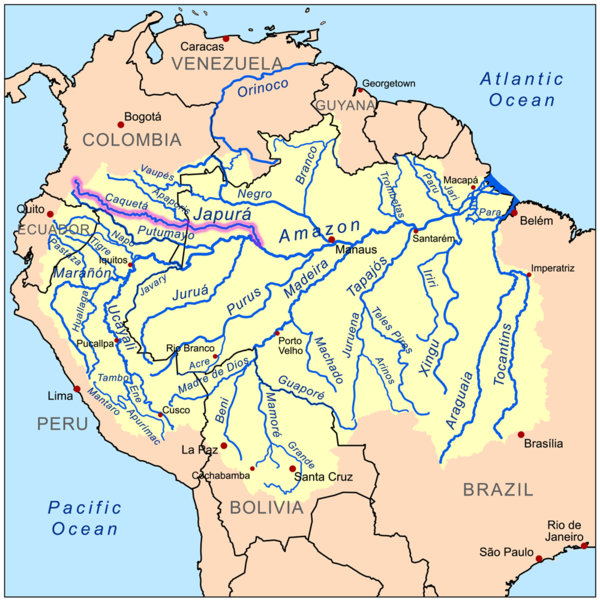
The Japurá River or Caquetá River is a river about 2,820 kilometres (1,750 mi) long rising as the Caquetá River in the Andes in the Southwet of Colombia. It flows southeast into Brazil, where it is called the Japurá. The Japurá enters the Amazon River through a network of channels. It is navigable by small boats in Brazil.
The river is home to a wide variety of fish and reptiles, including enormous catfish weighing up to 91 kg (201 lb) and measuring up to 1.8 metres (5.9 ft) in length, electric eels, piranhas, turtles, and caimans. It also serves as a principal means of transportation, being plied by tiny dugout canoes, larger ones, motorboats, and riverboats known locally as lanchas. The boats carry a multitude of cargoes, sometimes being chartered, sometimes even being traveling general stores. In the Colombian section, the presence of guerrillas and soldiers often severely limits river traffic.
Much of the jungle through which the eastern Caquetá originally flowed has been cleared for pasture, crops of rice, corn, manioc, and sugar cane, and in the past two decades, particularly coca crops.
West of the Rio Negro, the Solimões River (as the Amazon’s upper Brazilian course is called) receives three more imposing streams from the northwest—the Japurá, the Içá (referred to as the Putumayo before it crosses over into Brazil), and the Napo. The Caquetá River, later to become the Japurá, rises in the Colombian Andes, nearly in touch with the sources of the Magdalena River, and augments its volume from many branches as it courses through Colombia.
The 19th-century Brazilian historian and geographer José Coelho da Gama e Abreu, the Baron of Marajó, attributed 970 kilometres (600 mi) of navigable stretches to it. Jules Crevaux, who descended it, described it as full of obstacles to navigation, the current very strong and the stream frequently interrupted by rapids and cataracts. It was initially supposed to have eight mouths, but colonial administrator Francisco Xavier Ribeiro Sampaio, in the historic report of his voyage of 1774, determined that there was but one real mouth, and that the supposed others are all furos or canos, as the diverting secondary channels of the Amazonian rivers are known.
In 1864–1868, the Brazilian government made a somewhat careful examination of the Brazilian part of the river, as far up as the rapid of Cupati. Several very easy and almost complete water routes exist between the Japurá and Negro across the low, flat intervening country. The Baron of Marajó wrote that there were six of them, and one which connects the upper Japurá with the Vaupés branch of the Negro; thus the indigenous tribes of the respective valleys have easy contact with each other.
Note : The above story is based on materials provided by Wikipedia.
A stiff new layer in Earth’s mantle

By crushing minerals between diamonds, a University of Utah study suggests the existence of an unknown layer inside Earth: part of the lower mantle where the rock gets three times stiffer. The discovery may explain a mystery: why slabs of Earth’s sinking tectonic plates sometimes stall and thicken 930 miles underground.
The findings – published today in the journal Nature Geoscience – also may explain some deep earthquakes, hint that Earth’s interior is hotter than believed, and suggest why partly molten rock or magmas feeding midocean-ridge volcanoes such as Iceland’s differ chemically from magmas supplying island volcanoes like Hawaii’s.
“The Earth has many layers, like an onion,” says Lowell Miyagi, an assistant professor of geology and geophysics at the University of Utah. “Most layers are defined by the minerals that are present. Essentially, we have discovered a new layer in the Earth. This layer isn’t defined by the minerals present, but by the strength of these minerals.”
Earth’s main layers are the thin crust 4 to 50 miles deep (thinner under oceans, thicker under continents), a mantle extending 1,800 miles deep and the iron core. But there are subdivisions. The crust and some of the upper mantle form 60- to 90-mile-thick tectonic or lithospheric plates that are like the top side of conveyor belts carrying continents and seafloors.
Oceanic plates collide head-on with continental plates offshore from Chile, Peru, Mexico, the Pacific Northwest, Alaska, Kamchatka, Japan and Indonesia. In those places, the leading edge of the oceanic plate bends into a slab that dives or “subducts” under the continent, triggering earthquakes and volcanism as the slabs descend into the mantle, which is like the bottom part of the conveyor belt. The subduction process is slow, with a slab averaging roughly 300 million years to descend, Miyagi estimates.
Miyagi and fellow mineral physicist Hauke Marquardt, of Germany’s University of Bayreuth, identified the likely presence of a superviscous layer in the lower mantle by squeezing the mineral ferropericlase between gem-quality diamond anvils in presses. They squeezed it to pressures like those in Earth’s lower mantle. Bridgmanite and ferropericlase are the dominant minerals in the lower mantle.
The researchers found that ferropericlase’s strength starts to increase at pressures equivalent to those 410 miles deep – the upper-lower mantle boundary – and the strength increases threefold by the time it peaks at pressure equal to a 930-mile depth.
And when they simulated how ferropericlase behaves mixed with bridgmanite deep underground in the upper part of the lower mantle, they calculated that the viscosity or stiffness of the mantle rock at a depth of 930 miles is some 300 times greater than at the 410-mile-deep upper-lower mantle boundary.
“The result was exciting,” Miyagi says. “This viscosity increase is likely to cause subducting slabs to get stuck – at least temporarily – at about 930 miles underground. In fact, previous seismic images show that many slabs appear to ‘pool’ around 930 miles, including under Indonesia and South America’s Pacific coast. This observation has puzzled seismologists for quite some time, but in the last year, there is new consensus from seismologists that most slabs pool.”
How stiff or viscous is the viscous layer of the lower mantle? On the pascal-second scale, the viscosity of water is 0.001, peanut butter is 200 and the stiff mantle layer is 1,000 billion billion (or 10 to the 21st power), Miyagi says.
Slab subduction triggers earthquakes and volcanoes
For the new study, Miyagi’s funding came from the U.S. National Science Foundation and Marquardt’s from the German Science Foundation.
“Plate motions at the surface cause earthquakes and volcanic eruptions,” Miyagi says. “The reason plates move on the surface is that slabs are heavy, and they pull the plates along as they subduct into Earth’s interior. So anything that affects the way a slab subducts is, up the line, going to affect earthquakes and volcanism.”
He says the stalling and buckling of sinking slabs at due to a stiff layer in the mantle may explain some deep earthquakes higher up in the mantle; most quakes are much shallower and in the crust. “Anything that would cause resistance to a slab could potentially cause it to buckle or break higher in the slab, causing a deep earthquake.”
Miyagi says the stiff upper part of the lower mantle also may explain different magmas seen at two different kinds of seafloor volcanoes
Recycled crust and mantle from old slabs eventually emerges as new seafloor during eruptions of volcanic vents along midocean ridges – the rising end of the conveyor belt. The magma in this new plate material has the chemical signature of more recent, shallower, well-mixed magma that had been subducted and erupted through the conveyor belt several times. But in island volcanoes like Hawaii, created by a deep hotspot of partly molten rock, the magma is older, from deeper sources and less well-mixed.
Miyagi says the viscous layer in the lower mantle may be what separates the sources of the two different magmas that supply the two different kinds of volcanoes.
Another implication of the stiff layer is that “if you decrease the ability of the rock in the mantle to mix, it’s also harder for heat to get out of the Earth, which could mean Earth’s interior is hotter than we think,” Miyagi says.
He says scientists believe the average temperature and pressure 410 miles deep at the upper-lower mantle boundary is 2,800 degrees Fahrenheit and 235,000 times the atmospheric pressure on Earth’s surface. He calculates that at the viscous layer’s stiffest area, 930 miles deep, the temperature averages 3,900 degrees Fahrenheit and pressure is 640,000 times the air pressure at Earth’s surface.
Studying Earth’s interior by squeezing crystals
Such conditions prevent geophysicists from visiting Earth’s mantle, so “we know a lot more about the surface of Mars than we do Earth’s interior,” Miyagi says. “We can’t get down there, so we have to do experiments to see how these minerals behave under a wide range of conditions, and use that to simulate the behavior of the Earth.”
To do that, “you take two gem quality diamonds and trap a sample between the tips,” he says. “The sample is about the diameter of a human hair. Because the diamond tips are so small, you generate very high pressure just by turning the screws on the press by hand with Allen wrenches.”
Using diamond anvils, the researchers squeezed thousands of crystals of ferropericlase at pressures up to 960,000 atmospheres. They used ferropericlase with 10 percent and 20 percent iron to duplicate the range found in the mantle.
To observe and measure the spacing of atoms in ferropericlase crystals as they were squeezed in diamond anvils, the geophysicists bombarded the crystals with X-rays from an accelerator at Lawrence Berkeley National Laboratory in California, revealing the strength of the mineral at various pressures and allowing the simulations showing how the rock becomes 300 times more viscous at the 930-mile depth than at 410 miles.
The finding was a surprise because researchers previously believed that viscosity varied only a little bit at temperatures and pressures in the planet’s interior.
The study’s simulations also determined that just below the 930-mile-deep zone of highest viscosity, slabs sink more easily again as the lower mantle becomes less stiff, which happens because atoms can move more easily within ferropericlase crystals.
Descending slabs have been seen as deep as the core-mantle boundary 1,800 miles underground. As the bottom of the conveyor-belt-like mantle slowly moves, the slabs mix with the surrounding rock before the mixture erupts anew millions of years later and thousands of miles away at midocean ridges.
Reference:
Hauke Marquardt, Lowell Miyagi. Slab stagnation in the shallow lower mantle linked to an increase in mantle viscosity. Nature Geoscience, 2015; DOI: 10.1038/ngeo2393
Note: The above story is based on materials provided by University of Utah.
Archivists unearth rare first edition of the 1815 ‘Map that Changed the World’
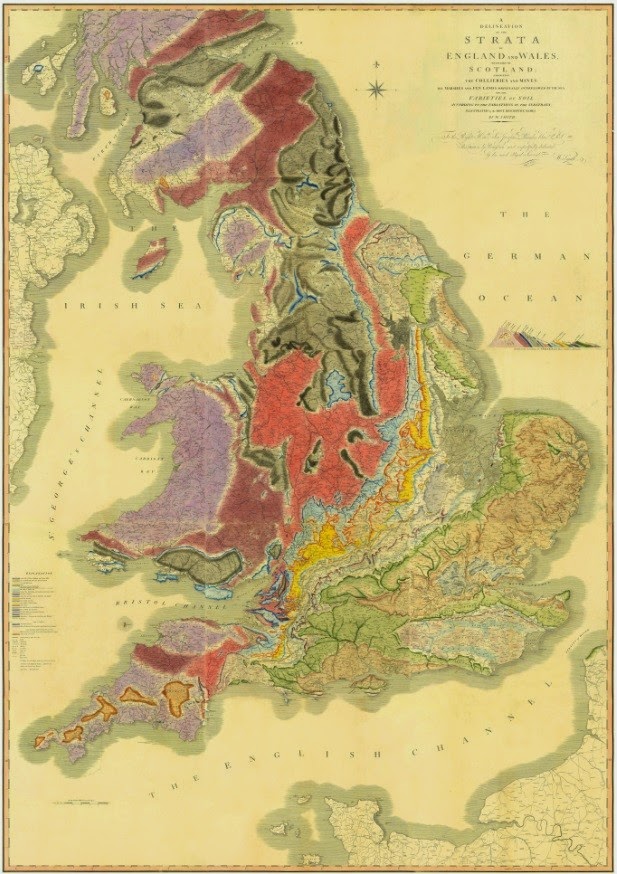
A rare early copy of William Smith’s 1815 Geological Map of England and Wales, previously thought lost, has been uncovered by Geological Society archivists. The new map has been digitised and made available online in time for the start of celebrations of the map’s 200th anniversary, beginning with an unveiling of a plaque at Smith’s former residence by Sir David Attenborough.
The map, the first geological map of a nation ever produced, shows the geological strata of England, Wales and part of Scotland. The newly discovered copy is thought to have been one of the first ten produced by William Smith (1769-1839), who went on to produce an estimated 370 hand-coloured copies of the map in his lifetime.
Now fully restored and digitised, images of the new map can be viewed on the Geological Society’s image library from March 23 — William Smith’s birthday. It will also be on display at the Geological Society during a number of events celebrating the map’s bicentennial.
Often called ‘the Father of English Geology’, William Smith pioneered the science of stratigraphy and geological mapping. His map of England and Wales became the basis for all future geological maps of Britain, and influenced geological surveys around the world.
‘Smith’s importance to the history of our science cannot be overstated’ says John Henry, Chair of the Geological Society’s History of Geology Group. ‘His map is a remarkable piece of work. It helped shape the economic and scientific development of Britain, at a time before geological surveys existed.’
Smith’s story was popularised by Simon Winchester’s 2001 book, ‘The Map that Changed the World’, which tells the story of his relationship with the Geological Society, who produced their own geological map of Britain in 1820.
‘These maps are extremely rare’ says Henry. ‘Each one is a treasure, and to have one of the very first produced is tremendously exciting.’
Although it is difficult to estimate the value of individual William Smith maps, an early copy was recently made available for sale at £150,000. The newly discovered map was found by the Society’s then Archive Assistant Victoria Woodcock in 2014, during an audit of the Society’s archives led by Geological Society Archivist Caroline Lam.
‘The map was found among completely unrelated material, so at first I didn’t realise the significance of what I’d uncovered’ says Woodcock. ‘Once we had worked out that it was an early copy of one of the earliest geological maps ever made, I was astonished. It’s the kind of thing that anyone working in archives dreams of, and definitely the highlight of my career so far!’
The map was identified as a first edition due to its lack of serial number, and geological features which Smith was known to have updated on later versions.
‘The very first batch of maps Smith produced did not have a series number or signature’ says Henry. ‘Other indications that it is a first edition is the geology depicted on the Isle of Wight, the lack of an engraved line on the Welsh border, and lack of granite around Eskdale in the Lake District.’
Records of the Geological Society’s Council minutes from 1815 suggest the map was purchased by the Society in that year for the sum of £5 5s. Since then, its ‘disappearance’ means it has rarely been exposed to light, preserving the incredibly bright original colours.
A number of organisations, including the Geological Society, the Natural History Museum, the British Geological Survey and National Museum Wales, are joining together throughout 2015 to celebrate the bicentennial of William Smith’s map through a range of events.
‘We’re incredibly excited by the discovery’ says Geological Society President Professor David Manning. ‘It’s wonderful that the map has been restored and made publicly available in time for the bicentennial celebrations, and we’re very grateful to the sponsors who have made this possible.’
Note: The above story is based on materials provided by Geological Society of London.
Slight surface movements on the radar
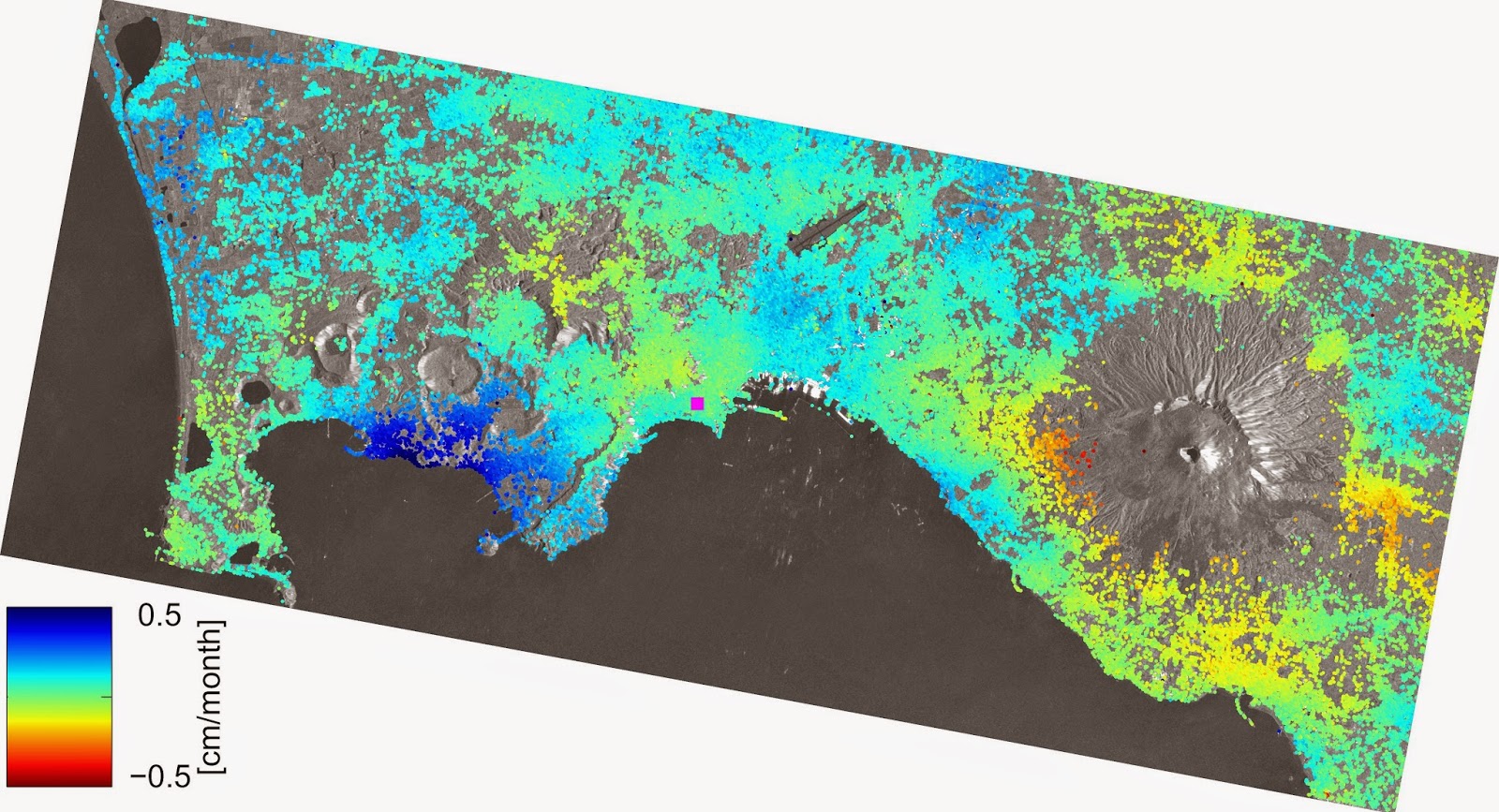
Scientists are making advances in the use of satellite radar data – such as those from the Sentinel-1 mission – to monitor Earth’s changing surface.
Italy’s Phlegraean Fields – or Campi Flegrei – is a large, active volcanic area near the city of Naples and Mount Vesuvius, characterised by continuous ground deformations owing to its volcanic nature.
“In 2012, deformation rates up to 3 cm a month prompted the Italian Civil Protection Department to move from the base (green) alert level of the Campi Flegrei Emergency Plan to the attention (yellow) level,” said Sven Borgstrom from Italy’s National Institute for Geophysics and Volcanology.
“The uplift continues today: radar imagery from the Sentinel-1A satellite captured over the area between October 2014 and March 2015 show that the ground is rising by about 0.5 cm per month.”
This is just one of the many findings being presented this week at the Fringe Workshop on advances in the science and applications of ‘SAR interferometry’ held at ESRIN, ESA’s centre for Earth observation, in Frascati, Italy.
Interferometric Synthetic Aperture Radar, or InSAR, is a remote sensing technique where two or more images of the same area are combined to detect slight changes occurring between acquisitions.
Tiny changes on the ground cause changes in the radar signal and lead to rainbow-coloured interference patterns in the combined image, known as an ‘interferogram’.
The Fringe Workshop takes its name from these coloured fringes seen in the interferograms.
Small movements – down to a scale of a few millimetres – can be detected across wide areas. Tectonic plates grinding past one another, the slow ‘breathing’ of active volcanoes, the slight sagging of a city street through groundwater extraction, and even the thermal expansion of a building on a sunny day.
This year, the workshop is paying particular attention to new results from the Sentinel-1 mission. Launched in April of last year, Sentinel-1A became the first satellite in orbit for Europe’s Copernicus programme, and has been delivering important data for an array of operational and scientific applications.
In Norway’s Svalbard archipelago, Sentinel-1 data are being used to monitor ice loss from the Austfonna ice cap. Earlier this year, the satellite captured the ice cap’s outlet glacier flowing at 3 cm per day.
With over 420 participants, this year’s Fringe workshop has seen the largest turnout since its inauguration in 1991 – when four specialists met to discuss the early InSAR results from the ERS-1 mission. Radar interferometry has come a long way since, with contributions from satellites such as Envisat and now Sentinel-1A.
Note : The above story is based on materials provided by European Space Agency.
3D satellite, GPS earthquake maps isolate impacts in real time
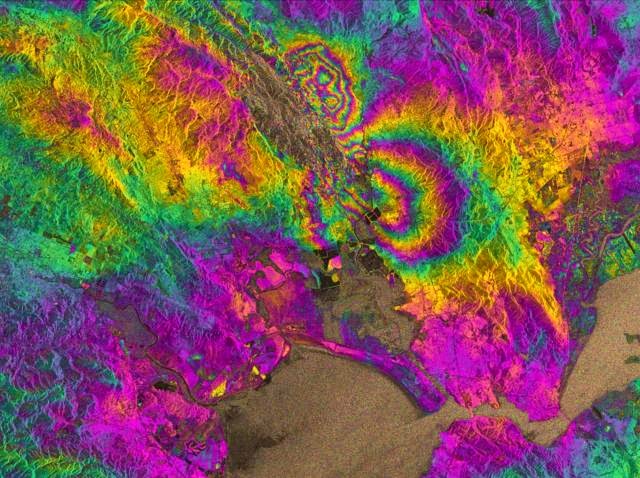
When an earthquake hits, the faster first responders can get to an impacted area, the more likely infrastructure—and lives—can be saved.
New research from the University of Iowa, along with the United States Geological Survey (USGS), shows that GPS and satellite data can be used in a real-time, coordinated effort to fully characterize a fault line within 24 hours of an earthquake, ensuring that aid is delivered faster and more accurately than ever before.
Earth and Environmental Sciences assistant professor William Barnhart used GPS and satellite measurements from the magnitude 6.0 South Napa, California earthquake on August 24, 2014, to create a three-dimensional map of how the ground surface moved in response to the earthquake. The map was made without using traditional rapid response instruments, such as seismometers, which may not afford the same level of detail for similar events around the globe.
“By having the 3D knowledge of the earthquake itself, we can make predictions of the ground shaking, without instruments to record that ground shaking, and then can make estimates of what the human and infrastructure impacts will be— in terms of both fatalities and dollars,” Barnhart says.
The study, “Geodetic Constraints on the 2014 M 6.0 South Napa Earthquake” published in the March/April edition of Seismological Research Letters, is the first USGS example showing that GPS and satellite readings can be used as a tool to shorten earthquake response times.
And while information about an earthquake’s impact might be immediately known in an area such as southern California, Barnhart says the technique will be most useful in the developing world. The catastrophic magnitude 7.0 earthquake that hit Haiti in 2010 is the perfect example for the usefulness of this kind of tool, Barnhart says. The earthquake struck right under the capital city of Port Au Prince, killing up to 316,000 people, depending on estimates, and costing billions of dollars in aid.
“On an international scale, it dramatically reduces the time between when an earthquake happens, when buildings start to fall down, and when aid starts to show up,” Barnhart says.
To accurately map the South Napa earthquake for this study, Barnhart and a team of researchers created a complex comparison scenario.
They first used GPS and satellite readings to measure the very small- millimeter-to-centimeter-sized-displacements of the ground’s surface that were caused by the earthquake. They fed those measurements into a mathematical equation that inverts the data and relates how much the ground moved to the degree of slip on the fault plane. Slip describes the amount, timing, and distribution of fault plane movement during an earthquake.
This allowed the group to determine the location, orientation, and dimensions of the entire fault without setting foot on the ground near the earthquake. The mathematical inversion gave the researchers predictions of how much the ground might be displaced, and they compared those results to their initial estimations, bit by bit, until their predictions and observations match. The resulting model is a 3D map of fault slip beneath the Earth’s surface. The entire procedure takes only a few minutes to complete.
Nationally, there is a push to create an earthquake early-warning system, which is already being tested internally by the USGS in coordination with the University of California, Berkeley; the California Institute of Technology; and the University of Washington. While only researchers, first responders, and other officials received the early warning message, it did work in testing for the Bay Area during the Napa earthquake. Individuals in Berkeley received nearly 10 seconds of advanced warning before the ground began shaking. The information contained in Barnhart’s study could be used to create further tools for predicting the economic and human tolls of earthquakes.
“That’s why this is so important. It really was the chance to test all these tools that have been put into place,” Barnhart says. “It happened in a perfect place, because now we’re much more equipped for a bigger earthquake.”
Note : The above story is based on materials provided by University of Iowa.
Super-salamander: Earth’s top predators more than 200 million years ago

A previously undiscovered species of crocodile-like amphibian that lived during the rise of dinosaurs was among Earth’s top predators more than 200 million years ago, a study shows.
Palaeontologists identified the prehistoric species – which looked like giant salamanders – after excavating bones buried on the site of an ancient lake in southern Portugal.
The species was part of a wider group of primitive amphibians that were widespread at low latitudes 220-230 million years ago, the team says.
The creatures grew up to 2m in length and lived in lakes and rivers during the Late Triassic Period, living much like crocodiles do today and feeding mainly on fish, researchers say.
The species – Metoposaurus algarvensis – lived at the same time as the first dinosaurs began their dominance, which lasted for over 150 million years, the team says. These primitive amphibians formed part of the ancestral stock from which modern amphibians – such as frogs and newts – evolved, researchers say.
The species were distant relatives of the salamanders of today, the team says. The discovery reveals that this group of amphibians was more geographically diverse than previously thought.
The species is the first member of the group to be discovered in the Iberian Peninsula, the team says.
Fossil remains of species belonging to the group have been found in parts of modern day Africa, Europe, India and North America. Differences in the skull and jaw structure of the fossils found in Portugal revealed they belong to a separate species.
The new species was discovered in a large bed of bones where up to several hundred of the creatures may have died when the lake they inhabited dried up, researchers say. Only a fraction of the site – around 4 square meters – has been excavated so far, and the team is continuing work there in the hope of unearthing new fossils.
Most members the group of giant salamander-like amphibians was wiped out during a mass extinction 201 million years ago, long before the death of the dinosaurs. This marked the end of the Triassic Period, when the supercontinent of Pangea – which included all the world’s present-day continents – began to break apart. The extinction wiped out many groups of vertebrates, such as big amphibians, paving the way for dinosaurs to become dominant.
The study, published in the Journal of Vertebrate Paleontology, was funded by the German Research Foundation and the National Science Foundation, the Jurassic Foundation, CNRS, Columbia University Climate Center and the Chevron Student Initiative Fund. Additional support was provided by the Municipality of Loulé, Camara Municipal de Silves and Junta de Freguesia de Salir in Portugal.
Dr Steve Brusatte, of the University of Edinburgh’s School of GeoSciences, who led the study, said: “This new amphibian looks like something out of a bad monster movie. It was as long as a small car and had hundreds of sharp teeth in its big flat head, which kind of looks like a toilet seat when the jaws snap shut. It was the type of fierce predator that the very first dinosaurs had to put up with if they strayed too close to the water, long before the glory days of T. rex and Brachiosaurus.”
Dr Richard Butler, of the School of Geography, Earth and Environmental Sciences at the University of Birmingham, said: “Most modern amphibians are pretty tiny and harmless. But back in the Triassic these giant predators would have made lakes and rivers pretty scary places to be.”
Dr Steve Brusatte will discuss his work on recently discovered species and other aspects of palaeontology at a series of events at the Edinburgh International Science Festival, which runs from 4-19 April.
Note : The above story is based on materials provided by University of Edinburgh.
World’s largest asteroid impacts found in central Australia

A 400 kilometre-wide impact zone from a huge meteorite that broke in two moments before it slammed into the Earth has been found in Central Australia.
The crater from the impact millions of years ago has long disappeared. But a team of geophysicists has found the twin scars of the impacts – the largest impact zone ever found on Earth – hidden deep in the earth’s crust.
Lead researcher Dr Andrew Glikson from The Australian National University (ANU) said the impact zone was discovered during drilling as part of geothermal research, in an area near the borders of South Australia, Queensland and the Northern Territory.
“The two asteroids must each have been over 10 kilometres across – it would have been curtains for many life species on the planet at the time,” said Dr Glikson, from the ANU School of Archaeology and Anthropology.
The revelation of such ancient violent impacts may lead to new theories about the Earth’s history.
“Large impacts like these may have had a far more significant role in the Earth’s evolution than previously thought,” Dr Glikson said.
The exact date of the impacts remains unclear. The surrounding rocks are 300 to 600 million years old, but evidence of the type left by other meteorite strikes is lacking.
For example, a large meteorite strike 66 million years ago sent up a plume of ash which is found as a layer of sediment in rocks around the world. The plume is thought to have led to the extinction of a large proportion of the life on the planet, including many dinosaur species.
However, a similar layer has not been found in sediments around 300 million years old, Dr Glikson said.
“It’s a mystery – we can’t find an extinction event that matches these collisions. I have a suspicion the impact could be older than 300 million years,” he said.
A geothermal research project chanced on clues to the impacts while drilling more than two kilometres into the earth’s crust.
The drill core contained traces of rocks that had been turned to glass by the extreme temperature and pressure caused by a major impact.
Magnetic modelling of the deep crust in the area traced out bulges hidden deep in the Earth, rich in iron and magnesium, corresponding to the composition of the Earth mantle.
“There are two huge deep domes in the crust, formed by the Earth’s crust rebounding after the huge impacts, and bringing up rock from the mantle below,” Dr Glikson said.
The two impact zones total more than 400 kilometres across, in the Warburton Basin in Central Australia. They extend through the Earth’s crust, which is about 30 kilometres thick in this area.
The research has been published in journal Tectonophysics.
Reference:
Geophysical anomalies and quartz deformation of the Warburton West structure, central Australia , doi:10.1016/j.tecto.2014.12.010
Note : The above story is based on materials provided by The Australian National University, Canberra.
International study raises questions about cause of global ice ages
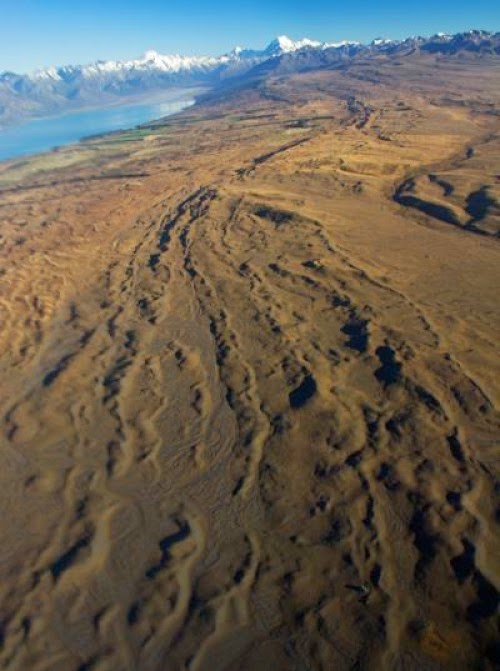
A new international study casts doubt on the leading theory of what causes ice ages around the world — changes in the way the Earth orbits the sun.
The researchers found that glacier movement in the Southern Hemisphere is influenced primarily by sea surface temperature and atmospheric carbon dioxide rather than changes in the Earth’s orbit, which are thought to drive the advance and retreat of ice sheets in the Northern Hemisphere.
The findings appear in the journal Geology.
The study raises questions about the Milankovitch theory of climate, which says the expansion and contraction of Northern Hemisphere continental ice sheets are influenced by cyclic fluctuations in solar radiation intensity due to wobbles in the Earth’s orbit; those orbital fluctuations should have an opposite effect on Southern Hemisphere glaciers.
“Records of past climatic changes are the only reason scientists are able to predict how the world will change in the future due to warming. The more we understand about the cause of large climatic changes and how the cooling or warming signals travel around the world, the better we can predict and adapt to future changes,” says lead author Alice Doughty, a glacial geologist at Dartmouth College who studies New Zealand mountain glaciers to understand what causes large-scale global climatic change such as ice ages. “Our results point to the importance of feedbacks — a reaction within the climate system that can amplify the initial climate change, such as cool temperatures leading to larger ice sheets, which reflect more sunlight, which cools the planet further. The more we know about the magnitude and rates of these changes and the better we can explain these connections, the more robust climate models can be in predicting future change.”
The researchers used detailed mapping and beryllium-10 surface exposure dating of ice-age moraines — or rocks deposited when glaciers move — in New Zealand’s Southern Alps, where the glaciers were much bigger in the past. The dating method measures beryllium-10, a nuclide produced in rocks when they are struck by cosmic rays. The researchers identified at least seven episodes of maximum glacier expansion during the last ice age, and they also dated the ages of four sequential moraine ridges. The results showed that New Zealand glaciers were large at the same time that large ice sheets covered Scandinavia and Canada during the last ice age about 20,000 years ago. This makes sense in that the whole world was cold at the same time, but the Milankovitch theory should have opposite effects for the Northern and Southern Hemispheres, and thus cannot explain the synchronous advance of glaciers around the globe. Previous studies have shown that Chilean glaciers in the southern Andes also have been large at the same time as Northern Hemisphere ice sheets.
The ages of the four New Zealand ridges — about 35,500; 27,170; 20,270; and 18,290 years old — instead align with times of cooler sea surface temperatures off the coast of New Zealand based on offshore marine sediment cores. The timing of the Northern Hemisphere’s ice ages and large ice sheets is still paced by how Earth orbits the Sun, but how the cooling and warming signals are transferred around the world has not been fully explained, although ocean currents (flow direction, speed and temperature) play a significant role.
Reference:
Alice M. Doughty, Joerg M. Schaefer, Aaron E. Putnam, George H. Denton, Michael R. Kaplan, David J.a. Barrell, Bjørn G. Andersen, Samuel E. Kelley, Robert C. Finkel, And Roseanne Schwartz. Mismatch of glacier extent and summer insolation in Southern Hemisphere mid-latitudes. Geology, 2015 DOI: 10.1130/G36477.1
Note: The above story is based on materials provided by Dartmouth College.
Japan opts for massive, costly sea wall to fend off tsunamis

Four years after a towering tsunami ravaged much of Japan’s northeastern coast, efforts to fend off future disasters are focusing on a nearly 400-kilometer (250-mile) chain of cement sea walls, at places nearly five stories high.
Opponents of the 820 billion yen ($6.8 billion) plan argue that the massive concrete barriers will damage marine ecology and scenery, hinder vital fisheries and actually do little to protect residents who are mostly supposed to relocate to higher ground. Those in favor say the sea walls are a necessary evil, and one that will provide some jobs, at least for a time.
In the northern fishing port of Osabe, Kazutoshi Musashi chafes at the 12.5-meter (41-foot)-high concrete barrier blocking his view of the sea.
“The reality is that it looks like the wall of a jail,” said Musashi, 46, who lived on the seaside before the tsunami struck Osabe and has moved inland since.
Pouring concrete for public works is a staple strategy for the ruling Liberal Democratic Party and its backers in big business and construction, and local officials tend to go along with such plans.
The paradox of such projects, experts say, is that while they may reduce some damage, they can foster complacency. That can be a grave risk along coastlines vulnerable to tsunamis, storm surges and other natural disasters. At least some of the 18,500 people who died or went missing in the 2011 disasters failed to heed warnings to escape in time.
Tsuneaki Iguchi was mayor of Iwanuma, a town just south of the region’s biggest city, Sendai, when the tsunami triggered by a magnitude-9 earthquake just off the coast inundated half of its area.
A 7.2-meter (24-foot) -high sea wall built years earlier to help stave off erosion of Iwanuma’s beaches slowed the wall of water, as did stands of tall, thin pine trees planted along the coast. But the tsunami still swept up to 5 kilometers (3 miles) inland. Passengers and staff watched from the upper floors and roof of the airport as the waves carried off cars, buildings and aircraft, smashing most homes in densely populated suburbs not far from the beach.
The city repaired the broken sea walls but doesn’t plan to make them any taller. Instead, Iguchi was one of the first local officials to back a plan championed by former Prime Minister Morihiro Hosokawa to plant mixed forests along the coasts on tall mounds of soil or rubble, to help create a living “green wall” that would persist long after the concrete of the bigger, man-made structures has crumbled.
“We don’t need the sea wall to be higher. What we do need is for everyone to evacuate,” Iguchi said.
“The safest thing is for people to live on higher ground and for people’s homes and their workplaces to be in separate locations. If we do that, we don’t need to have a ‘Great Wall,'” he said.
While the lack of basic infrastructure can be catastrophic in developing countries, too heavy a reliance on such safeguards can lead communities to be too complacent at times, says Margareta Wahlstrom, head of the U.N.’s Office for Disaster Risk Reduction.
“There’s a bit of an overbelief in technology as a solution, even though everything we have learned demonstrates that people’s own insights and instincts are really what makes a difference, and technology in fact makes us a bit more vulnerable,” Wahlstrom said in an interview ahead of a recent conference in Sendai convened to draft a new framework for reducing disaster risks.
In the steelmaking town of Kamaishi, more than 1,000 people died in the 2011 tsunami, but most school students fled to safety zones immediately after the earthquake, thanks to training by a civil engineering professor, Toshitaka Katada.
The risk is not confined to Japan, said Maarten van Aalst, director of the Red Cross/Red Crescent Climate Center, who sees this in the attitudes of fellow Dutch people who trust in their low-lying country’s defenses against the sea.
“The public impression of safety is so high, they would have no idea what to do in case of a catastrophe,” he said.
Despite pockets of opposition, getting people to agree to forego the sea walls and opt instead for Hosokawa’s “Great Forest Wall” plan is a tough sell, says Tomoaki Takahashi, whose job is to win support for the forest project in local communities.
“Actually, many people are in favor of the sea walls, because they will create jobs,” said Takahashi. “But even people who really don’t like the idea also feel as if they would be shunned if they don’t go along with those who support the plan,” he said.
While the “Great Forest Wall” being planted in some areas would not stave off flooding, it would slow tsunamis and weaken the force of their waves. As waters recede, the vegetation would help prevent buildings and other debris from flowing back out to sea. Such projects would also allow rain water to flow back into the sea, a vital element of marine ecology.
Some voices in unexpected places are urging a rethink of the plan.
Prime Minister Shinzo Abe’s wife, Akie, offered numerous objections to cementing the northeast coast in a speech in New York last September. She said the walls may prevent residents from keeping an eye out for future tsunamis and would be costly to maintain for already dwindling coastal communities.
“Please do not proceed even if it’s already decided,” she said. Instead of a one-size-fits-all policy, she suggested making the plan more flexible. “I ask, is building high sea walls to shield the coast line really, really the best?”
Rikuzentakata, a small city near Osabe whose downtown area was wiped out by the tsunami, is building a higher sea wall, but also moving many tons of earth to raise the land well above sea level.
Local leader Takeshi Konno said no construction project will eliminate the need for coastal residents to protect themselves.
“What I want to stress is that no matter what people try to create, it won’t beat nature, so we humans need to find a way to co-exist with nature,” Konno said. “Escaping when there is danger . the most important thing is to save your life.”
Note : The above story is based on materials provided by The Associated Press. All rights reserved..
Did a volcanic cataclysm 40,000 years ago trigger the final demise of the Neanderthals?
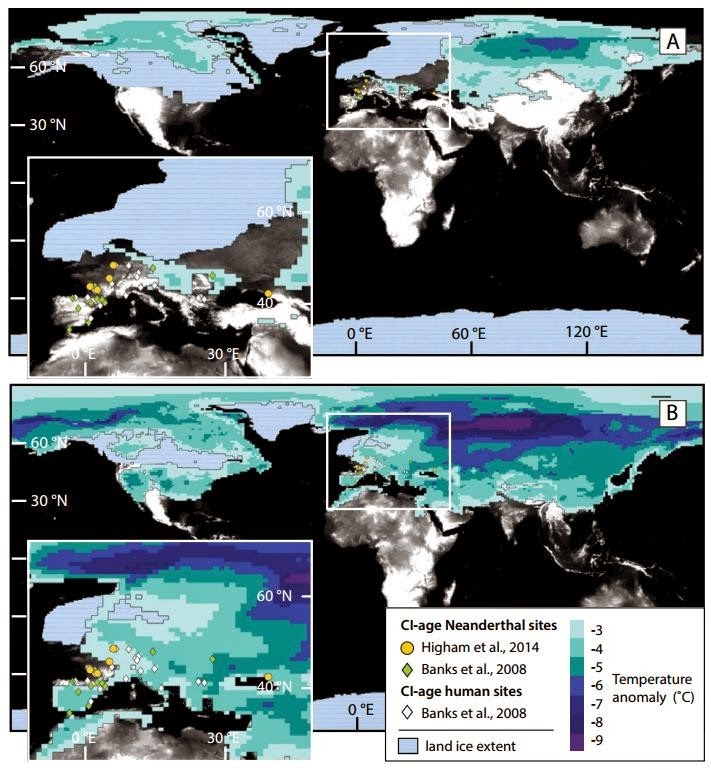
The Campanian Ignimbrite (CI) eruption in Italy 40,000 years ago was one of the largest volcanic cataclysms in Europe and injected a significant amount of sulfur-dioxide (SO2) into the stratosphere. Scientists have long debated whether this eruption contributed to the final extinction of the Neanderthals. This new study by Benjamin A. Black and colleagues tests this hypothesis with a sophisticated climate model.
Black and colleagues write that the CI eruption approximately coincided with the final decline of Neanderthals as well as with dramatic territorial and cultural advances among anatomically modern humans. Because of this, the roles of climate, hominin competition, and volcanic sulfur cooling and acid deposition have been vigorously debated as causes of Neanderthal extinction.
They point out, however, that the decline of Neanderthals in Europe began well before the CI eruption: “Radiocarbon dating has shown that at the time of the CI eruption, anatomically modern humans had already arrived in Europe, and the range of Neanderthals had steadily diminished. Work at five sites in the Mediterranean indicates that anatomically modern humans were established in these locations by then as well.”
“While the precise implications of the CI eruption for cultures and livelihoods are best understood in the context of archaeological data sets,” write Black and colleagues, the results of their study quantitatively describe the magnitude and distribution of the volcanic cooling and acid deposition that ancient hominin communities experienced coincident with the final decline of the Neanderthals.
In their climate simulations, Black and colleagues found that the largest temperature decreases after the eruption occurred in Eastern Europe and Asia and sidestepped the areas where the final Neanderthal populations were living (Western Europe). Therefore, the authors conclude that the eruption was probably insufficient to trigger Neanderthal extinction.
However, the abrupt cold spell that followed the eruption would still have significantly impacted day-to-day life for Neanderthals and early humans in Europe. Black and colleagues point out that temperatures in Western Europe would have decreased by an average of 2 to 4 degrees Celsius during the year following the eruption. These unusual conditions, they write, may have directly influenced survival and day-to-day life for Neanderthals and anatomically modern humans alike, and emphasize the resilience of anatomically modern humans in the face of abrupt and adverse changes in the environment.
Reference:
B. A. Black, R. R. Neely, M. Manga. Campanian Ignimbrite volcanism, climate, and the final decline of the Neanderthals. Geology, 2015; DOI: 10.1130/G36514.1
Note: The above story is based on materials provided by Geological Society of America.
Crocodile ancestor was top predator before dinosaurs roamed North America

A newly discovered crocodilian ancestor may have filled one of North America’s top predator roles before dinosaurs arrived on the continent. Carnufex carolinensis, or the “Carolina Butcher,” was a 9-foot long, land-dwelling crocodylomorph that walked on its hind legs and likely preyed upon smaller inhabitants of North Carolina ecosystems such as armored reptiles and early mammal relatives.
Paleontologists from North Carolina State University and the North Carolina Museum of Natural Sciences recovered parts of Carnufex’s skull, spine and upper forelimb from the Pekin Formation in Chatham County, North Carolina. Because the skull of Carnufex was preserved in pieces, it was difficult to visualize what the complete skull would have looked like in life. To get a fuller picture of Carnufex’s skull the researchers scanned the individual bones with the latest imaging technology — a high-resolution surface scanner. Then they created a three-dimensional model of the reconstructed skull, using the more complete skulls of close relatives to fill in the missing pieces.
The Pekin Formation contains sediments deposited 231 million years ago in the beginning of the Late Triassic (the Carnian), when what is now North Carolina was a wet, warm equatorial region beginning to break apart from the supercontinent Pangea. “Fossils from this time period are extremely important to scientists because they record the earliest appearance of crocodylomorphs and theropod dinosaurs, two groups that first evolved in the Triassic period, yet managed to survive to the present day in the form of crocodiles and birds,” says Lindsay Zanno, assistant research professor at NC State, director of the Paleontology and Geology lab at the museum, and lead author of a paper describing the find. “The discovery of Carnufex, one of the world’s earliest and largest crocodylomorphs, adds new information to the push and pull of top terrestrial predators across Pangea.”
Typical predators roaming Pangea included large-bodied rauisuchids and poposauroids, fearsome cousins of ancient crocodiles that went extinct in the Triassic Period. In the Southern Hemisphere, “these animals hunted alongside the earliest theropod dinosaurs, creating a predator pile-up,” says Zanno. However, the discovery of Carnufex indicates that in the north, large-bodied crocodylomorphs, not dinosaurs, were adding to the diversity of top predator niches. “We knew that there were too many top performers on the proverbial stage in the Late Triassic,” Zanno adds. “Yet, until we deciphered the story behind Carnufex, it wasn’t clear that early crocodile ancestors were among those vying for top predator roles prior to the reign of dinosaurs in North America.”
As the Triassic drew to a close, extinction decimated this panoply of predators and only small-bodied crocodylomorphs and theropods survived. “Theropods were ready understudies for vacant top predator niches when large-bodied crocs and their relatives bowed out,” says Zanno. “Predatory dinosaurs went on to fill these roles exclusively for the next 135 million years.”
Still, ancient crocodiles found success in other places. “As theropod dinosaurs started to make it big, the ancestors of modern crocs initially took on a role similar to foxes or jackals, with small, sleek bodies and long limbs,” says Susan Drymala, graduate student at NC State and co-author of the paper. “If you want to picture these animals, just think of a modern day fox, but with alligator skin instead of fur.”
Reference:
Lindsay E. Zanno, Susan Drymala, Sterling J. Nesbitt, Vincent P. Schneider. Early crocodylomorph increases top tier predator diversity during rise of dinosaurs. Scientific Reports, 2015; 5: 9276 DOI: 10.1038/srep09276
Note: The above story is based on materials provided by North Carolina State University.
Protein the clue to solving a Darwinian mystery

Scientists have resolved pieces of a nearly 200-year-old evolutionary puzzle surrounding the group of mammals that Charles Darwin called the “strangest animals ever discovered.” New research led by the Natural History Museum, the American Museum of Natural History and the University of York shows that South America’s native ungulates, or hooved mammals — the last of which disappeared only 10,000 years ago — are actually related to mammals like horses rather than elephants and other species with ancient evolutionary ties to Africa as some taxonomists have maintained. Published today in the journal Nature, the findings are based on fossil protein sequences, which allow researchers to peek back in time up to 10 times farther than they can with DNA.
Ian Barnes, Research Leader at the Natural History Museum and one of the paper’s authors, explained: “Although the bones of these animals had been studied for over 180 years, no clear picture of their origins had been reached. Our analyses began by investigating ancient DNA to try to resolve the problem.”
“Fitting South American ungulates to the mammalian family tree has always been a major challenge for palaeontologists, because anatomically they were these weird mosaics, exhibiting features found in a huge variety of quite unrelated species living all over the place,” said Ross MacPhee, one of the paper’s authors and a curator in the American Museum of Natural History’s Department of Mammalogy. “This is what puzzled Darwin and his collaborator Richard Owen so much in the early 19th century. With all of these conflicting signals, they couldn’t say whether these ungulates were related to giant rodents, or elephants, or camels — or what have you.”
However, the team soon realized that ancient DNA — that is, genetic material extracted from fossils — did not survive in these fossils, because the DNA molecule survives poorly in the warm, wet conditions like those typical of South America. The breakthrough came when the researchers switched to analysing collagen, a structural protein found in all animal bones that can survive for a million years or more in a wide range of conditions. The chemical structure of the amino acids that make up a protein is ultimately dictated by specific coding sequences in the organism’s DNA. Because of this key relationship, amino acid compositions of the same protein in different species can be analysed and compared, providing insight into how closely the species are related.
“People have been successful in retrieving collagen sequences from specimens dating up to 4 million years old, and this is just the start,” said University of York Professor Matthew Collins, whose lab did the sequencing work. “On theoretical grounds, with material recovered from permafrost conditions, we might be able to reach back 10 million years.”
The scientists used proteomic analysis to screen 48 fossils of Toxodon platensis and Macrauchenia patachonica, the very species whose remains Darwin discovered 180 years ago in Uruguay and Argentina. “By selecting only the very best preserved bone specimens and with various improvements in proteomic analysis, we were able to obtain roughly 90 percent of the collagen sequence for both species,” said lead author Frido Welker, a Ph.D. student at the Max Planck Institute for Evolutionary Anthropology and the University of York. “This opens the way for various other applications in paleontology and paleoanthropology, which we are currently exploring.”
With modern techniques, the researchers were able to conclusively show that the closest living relatives of these species were the perissodactyls, the group that includes horses, rhinos, and tapirs. This makes them part of Laurasiatheria, one of the major groups of placental mammals. The molecular evidence corroborates a view held by some leading paleontologists that the ancestors of these South American ungulates came from North America more than 60 million years ago, probably just after the mass extinction that killed off non-avian dinosaurs and many other vertebrates.
Reference:
Frido Welker, Matthew J. Collins, Jessica A. Thomas, Marc Wadsley, Selina Brace, Enrico Cappellini, Samuel T. Turvey, Marcelo Reguero, Javier N. Gelfo, Alejandro Kramarz, Joachim Burger, Jane Thomas-Oates, David A. Ashford, Peter D. Ashton, Keri Rowsell, Duncan M. Porter, Benedikt Kessler, Roman Fischer, Carsten Baessmann, Stephanie Kaspar, Jesper V. Olsen, Patrick Kiley, James A. Elliott, Christian D. Kelstrup, Victoria Mullin et al. Ancient proteins resolve the evolutionary history of Darwin’s South American ungulates. Nature, 2015 DOI: 10.1038/nature14249
Note: The above story is based on materials provided by University of York.

